England
 From Rationalwiki
From Rationalwiki 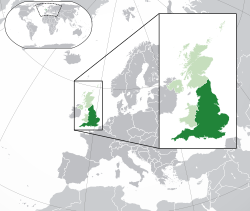
“”The greatness of England is now all collective: individually small, we only appear capable of anything great by our habit of combining; and with this our moral and religious philanthropists are perfectly contented. But it was men of another stamp than this that made England what it has been; and men of another stamp will be needed to prevent its decline.
|
| —John Stuart Mill[1] |
England is the largest and most populous constituent country of the United Kingdom. Its capital is London, a global financial hub. The country is known for founding the global British Empire, creating the Westminster system![]() of parliamentary government, having an extremely famous monarchy, being rained on far too frequently, and drinking lots of tea. On the other hand, England and its people have reputations for having boring and tasteless cuisine[2] and being unpleasant tourists in other countries.[3] It is the home of football, Monty Python, fish and chips, and Helena Bonham Carter. England is also the birthplace of the language you're reading in, commonly spoken across the United Kingdom and in other nations it historically influenced and colonized. For the more cynical, England is the land of casual bigotry and menial problems. In the 2021 census of England and Wales, less than half (46.2%) of respondents labeled themselves as "Christian", while 37.2% identified with "no religion".[4]
of parliamentary government, having an extremely famous monarchy, being rained on far too frequently, and drinking lots of tea. On the other hand, England and its people have reputations for having boring and tasteless cuisine[2] and being unpleasant tourists in other countries.[3] It is the home of football, Monty Python, fish and chips, and Helena Bonham Carter. England is also the birthplace of the language you're reading in, commonly spoken across the United Kingdom and in other nations it historically influenced and colonized. For the more cynical, England is the land of casual bigotry and menial problems. In the 2021 census of England and Wales, less than half (46.2%) of respondents labeled themselves as "Christian", while 37.2% identified with "no religion".[4]
England takes its name from the Angles, a Germanic tribe that migrated there after the collapse of Roman Empire's rule over the region. Together with the Saxons, the Germanic settlers established a series of petty kingdoms, displaced the native Brythonic culture, and defended against Viking raids and invasions that increased in frequency after 800 CE. During this time, the Anglo-Saxon kingdoms gradually converted to Christianity. The Kingdom of England was diplomatically and militarily unified in 927 CE by Æthelstan of the Kingdom of Wessex.
English history took a drastic turn in 1066 after William the Conqueror, the Duke of Normandy (in northern France) pressed his claim to the throne, invaded, and occupied the country. The merger of Anglo-Saxon and Norman cultures gave rise to the modern English nation. Under its new French nobility, England warred repeatedly with France, participated in the Crusades, and made moves towards conquering Wales and Ireland. This period also saw the foundation of the English Parliament and the signing of the Magna Carta. English claims to the French throne led to the Hundred Years' War![]() , which in turn led to a series of succession wars and the rise of the Tudor dynasty.
, which in turn led to a series of succession wars and the rise of the Tudor dynasty.
The Tudors turned England into a colonial power, conquered Ireland, and joined the Protestant Reformation by establishing the Church of England. The famous Tudor queen Elizabeth I![]() died without heirs, leading to the rise of the Stuart dynasty of Scotland to the English throne, creating a personal union between England and Scotland. Religious tensions and political conflicts between the Crown and Parliament exploded into the English Civil War in 1642, which briefly saw the monarchy abolished. The Stuart dynasty returned to the throne in 1660, but King James II was deposed due to being a Catholic and replaced by his Protestant daughter Mary and her husband, the Dutch Prince William of Orange. To end further disputes over the crown, now-King William III got Parliament to pass the Act of Settlement
died without heirs, leading to the rise of the Stuart dynasty of Scotland to the English throne, creating a personal union between England and Scotland. Religious tensions and political conflicts between the Crown and Parliament exploded into the English Civil War in 1642, which briefly saw the monarchy abolished. The Stuart dynasty returned to the throne in 1660, but King James II was deposed due to being a Catholic and replaced by his Protestant daughter Mary and her husband, the Dutch Prince William of Orange. To end further disputes over the crown, now-King William III got Parliament to pass the Act of Settlement![]() in 1701, which disqualified any Catholics from holding the English throne.
in 1701, which disqualified any Catholics from holding the English throne.
In 1707, Queen Anne fulfilled the longstanding ambition of centuries of English monarchs by granting royal assent to the Acts of Union![]() , which merged England and Scotland into a single country: the Kingdom of Great Britain. This new nation would go on to become an industrial, naval, and colonial superpower.
, which merged England and Scotland into a single country: the Kingdom of Great Britain. This new nation would go on to become an industrial, naval, and colonial superpower.
So what is England, exactly?[edit]
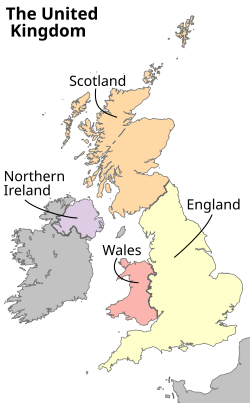
Get ready for confusion.
"England" is sometimes incorrectly used interchangeably with "United Kingdom" or "Great Britain". This is incorrect. The United Kingdom is a sovereign state that is comprised of four countries: England, Scotland, Wales, and Northern Ireland. It's essentially four countries in a trench coat, although its government is far more unitary than that would imply. England, therefore, is just a constituent part of the UK, despite being a country itself.
"Great Britain", meanwhile, is the main island body on which England and Scotland are located. Northern Ireland is not part of Great Britain. Although today just the name of an island, Great Britain also used to refer to the Kingdom of Great Britain,![]() a country that existed between 1707 and 1800.
a country that existed between 1707 and 1800.
The issue over naming conventions may have arisen from any of several factors:
- England is the largest and most populous country in the United Kingdom. Its capital, London, is the capital of the UK.
- England has, by far, the greatest population of any country in the UK. As of 2022, its population was 57.1 million, compared to the greater UK population of 67.6 million.[5] Therefore, if you're talking to someone from the UK, the chance is very strong that they're also from England.
- England itself doesn't actually have its own parliament the way the other constituent countries do, since such a body would represent too many people and therefore have too much power compared to the UK parliament.[6]
- English is the de facto language of the United Kingdom, although the UK has ten indigenous languages without getting into dialects.[7] The less said about accents, the better.
If you are still in doubt as to the status of England within the UK, tell a Scots, Welsh, or Irish person that they're English and see what kind of response you get.
History[edit]

Prehistory[edit]
The earliest hominid inhabitants of England (that modern archaeologists know about) were the Homo antecessor, who left behind tools dated to between 840,000 and 950,000 years ago.[8] Homo antecessor went extinct around 800,000 years ago,[9] but several subsequent hominid populations settled Britain in the interim. Between 50-40 thousand years ago modern humans arrived in Europe,[10] and these early modern humans also settled in Britain.[11] The increasingly harsh conditions of the last ice age drove humans out of Britain around 33,000 years ago.[12]:422 Evidence of human activity in the British Isles doesn't pop up for nearly another twenty thousand years, when Welsh rock-art dated to 14,000 years ago depicting reindeer shows up.[13] The Creswellian culture![]() takes root in Great Britain by around 12,000 BP, although the Younger Dryas
takes root in Great Britain by around 12,000 BP, although the Younger Dryas![]() renders Britain devoid of humans again for a period of time.[14] There has been continuous human occupation of Great Britain since the end of the Younger Dryas around 11,000 BP.[15]:243:270–72 These humans, however, being descendants of Mesolithic migrants from northern Iberia,[16][17] are largely unrelated to modern-day Britons, having been more-or-less replaced by Neolithic immigrants around 6,000 years ago.[18]
renders Britain devoid of humans again for a period of time.[14] There has been continuous human occupation of Great Britain since the end of the Younger Dryas around 11,000 BP.[15]:243:270–72 These humans, however, being descendants of Mesolithic migrants from northern Iberia,[16][17] are largely unrelated to modern-day Britons, having been more-or-less replaced by Neolithic immigrants around 6,000 years ago.[18]
4,500 years ago, settlers from central Europe arrived and supplanted the existing Neolithic population.[19] These new arrivals, called the "Beaker people", are distinctive for their pottery, funerary practices, and skill in metalworking. Around 3000 BCE, the Beaker people began building Stonehenge,[20] which was either a site for rituals or a landing pad for aliens.
Between 3100 and 2700 years ago another wave of migration from places in modern France and Spain (this section ended up way more topical than we expected) introduced the Celtic language and culture to Britain as shown by modern DNA analysis.[21] The Celts were an agrarian people organized into clans, and they constructed hillforts across ancient Britain to serve as political, economic and religious centres.[22] The Celts also had an active religious culture marked by funerary rituals, animal sacrifice, and the creation of religious items. There is also evidence that the Celts had a relatively egalitarian society, as women had a great degree of freedom in marriage, business, and land ownership.[22] This was remarked upon by visiting Romans like Julius Caesar, who viewed this as evidence that the Celts were barbarians.[22]
The Roman era[edit]
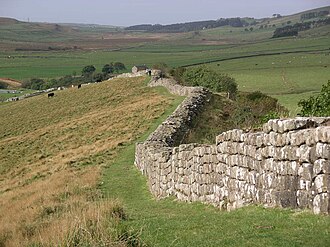
The Roman Empire invaded Britain in 43 CE, shortly after the accession of Emperor Claudius.[24] Claudius viewed this military adventure as a way to build up his prestige. Romans had been in Britain beforehand, most notably during the military expedition of Julius Caesar, but Caesar had only intended to win a propaganda victory by showing off some military victories and then leave.[24] Claudius' invasion was intended to outright conquer Britain.
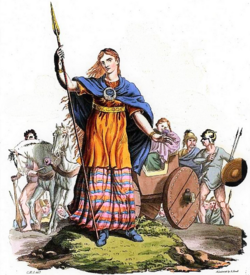
While the conquest was fairly swift, the Roman occupation had to contend against Celtic resistance for decades afterwards. In order to solidify their control, the Romans embarked on a military campaign in Wales to crush the druids, the priest-scholar class of ancient British society.[25] Their invasion of Wales resulted in massacres across the region.
In 60 CE, the Romans overstepped by attempting to annex the Iceni, an allied Celtic tribe, after the death of its king. When the king's wife, the legendary Boudica, objected, the Romans had her flogged and had her daughters raped.[26] Boudica led the Iceni into a revolt that resulted in the destruction of the Roman-established cities of Camulodunum, Londinium, and Verulamium and the deaths of 80,000 people.[26] Although she was defeated, the Romans replaced the governor of Britain and implemented more conciliatory policies towards the Celts. As her story was uncovered in the 19th century, Boudica became a national icon and was associated with then-queen Victoria.[27]
After consolidating their rule of the southern portion of Britain, the Romans introduced writing, legal codes, and the concept of the pub to British society.[24] However, their empire was an exploitative one, and their rule in Britain was primarily focused on creating wheat farms to feed other parts of the empire and extracting natural resources like gold and iron.[24] As a result of this style of governance, relatively little of their culture and laws went on to influence future kingdoms in Britain.
Roman rule in Britain ended in 410 CE as the Empire withdrew soldiers from the region in order to handle crises in other parts of the empire even as Picts were making incursions from the north and the Angles and Saxons were arriving by sea.[28] The Romans had little interest in defending such a backwater outpost when the center of the Empire was collapsing. Emperor Honorious effectively abandoned Britain by stating that the island would have to see to its own affairs.
The Anglo-Saxon era[edit]
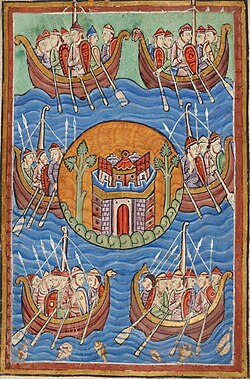
Arrival[edit]
Around 450 CE, Roman-style pottery, tools, and architecture became much rarer in England, reflecting a rapid cultural change brought about by the migration of Germanic peoples to England, specifically the Angles and Saxons.[29] Anglo-Saxons had been a large component of Rome's mercenary forces in Britain, so their people were aware that Britain was a relatively little-defended and comfortable place to land.[30] Climate change was probably a factor in motivating the migrations, as melting polar ice was causing flooding across northern Europe.[30] DNA evidence shows that the Anglo-Saxon migrations brought large numbers of both women and men to England and also indicates high rates of intermarriage and integration.[29] There is also relatively little archaeological evidence of armed conflict, so this period wasn't one of conquest by the Anglo-Saxons. For a nation that is today wracked by debates over immigration, the English people ironically have about 30% and 40% of their DNA from Anglo-Saxon migrants.[29]
This period does, however, give us the popular legend of King Arthur, who is said to have led armed Romano-British resistance to the Germanic peoples. He first appeared in Welsh poems in the 6th and early 7th centuries, and later Medieval writers added their own fantastical elements to the story like the magic sword Excalibur, the Knights of the Round Table, and Arthur's death at the Battle of Camlann against his own son Mordred.[31]
Back to real history, though, Celts in Scotland and Wales regarded the Anglo-Saxon arrivals with hostility. This is where the terms Sassenach in Scottish and Saesneg in Welsh come from.[30] Whatever their opinions, the Celts were unable to prevent the Anglo-Saxons from establishing a series of petty kingdoms across the region that is now England. Probably the most lasting impact left by the Anglo-Saxon migrations was their language. They brought the proto-Germanic Anglisc language to Britain, which gradually evolved into Old English.[32] This is why English is a West Germanic language.
The seven kingdoms[edit]
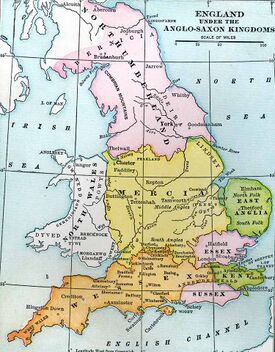
After a period of political chaos, the Anglo-Saxons consolidated into seven kingdoms (get the George R.R. Martin jokes out of your system now). Some of their names still survive as the names of English regions. These kingdoms were:
- Kent: This kingdom was established by Jutes from modern-day Denmark, and Arthurian legend states that they were invited there by the warlord Vortigern, a major villain of the story.[33] While this obviously didn't happen, the story probably does have a grain of truth in that Kent was settled by negotiation rather than warfare. Kent was centered around the city of Canterbury and prospered from trade links to Europe.[33]
- Essex: Established by the East Saxons (hence the name), this kingdom controlled the important Roman-era cities of London and Colchester.[33] It was fairly weak and was typically subordinate to other kingdoms.
- Sussex: Established by the South Saxons, this kingdom diverged culturally from the others as heavily forested regions separated it from the rest of England.[33] It was therefore the last to convert to Christianity.
- Northumbria: This large kingdom controlled most of northern England, including the city of York. Although it was powerful during the 600s CE, wars against the Picts in Scotland combined with internal political violence to greatly weaken it as time went on. Of the 14 kings during the 8th century, 4 were murdered, 6 were overthrown, and 2 chose to abdicate and become monks.[33] Job security for a Northumbrian king was pretty bad.
- East Anglia: As you can tell, this kingdom was settled by the East Angles. Its people were categorized as the North Folk (in modern Norfolk) and the South Folk (in Suffolk).[30] This kingdom was also wealthy due to trade from Europe.[33] It's almost as if trade from Europe is important or something.
- Mercia: This kingdom was dominant during the 700s CE. Mierce means "border" in Old English, and the 8th century king Offa famously built an earthwork barrier across his kingdom's border with the Welsh between between 757 and 796 CE.[34]
- Wessex: Founded by the West Saxons, this kingdom started off fairly weak before gaining strength during the 9th century. Wessex had the only recorded Anglo-Saxon queen, Seaxburh, although little was recorded of her reign.[35] Due to its rising strength over time, this kingdom went on to unite England.
With political instability being a problem for the Anglo-Saxons, the kings there relied heavily on loyal soldiers. The main thing the kings had to offer was land, titles to which were doled out to people who became the aristocratic class.[36]
Christianization[edit]

When they migrated, the Anglo-Saxons were primarily Germanic pagans whose religion was fairly similar to that of the Norse people. For instance, the Anglo-Saxon god "Woden" is similar to the Norse god "Odin" and "Thunor" is fairly obviously "Thor".[37] In the 595, Pope Gregory I dispatched the monk Augustine to the kingdom of Kent, which was at the time perceived to be the least hostile to the Christian religion.[38] This perception ended up being correct, as King Æthelberht allowed Augustine to establish a church at Canterbury (which is to this day a religiously significant city in England). Æthelberht was possibly influenced by his wife Bertha, who was a Christian from Francia.[38] The king later converted to Christianity.
Missionaries from Ireland, which had converted much earlier, were instrumental in spreading Christianity in Northumbria from 634 CE as well as the other Anglo-Saxon kingdoms.[37] Irish Christianity was far more decentralized than the Catholic Church wanted, and disagreeing interpretations on doctrine and religious organization led to a period of unrest and conflict in England. To address this, Pope Vitalian sent Theodore, a priest from the Eastern Roman Empire, to establish himself as the first official Archbishop of Canterbury and enforce the Church's authority.[37] In 673 CE, Theodore called Anglo-Saxon bishops to a council at Hertford where he laid down the laws and regulations that the Church expected them to follow.[37] He followed up in 679 CE by declaring that the English churches would adhere to the "true and orthodox" Roman tradition. From this point, England became a firmly Catholic nation for centuries afterwards.
Hide your shit, the Vikings are here[edit]
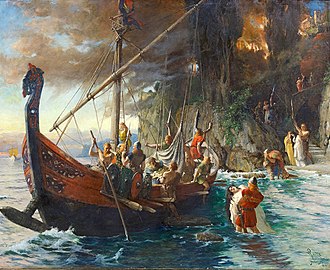
“”The church of St Cuthbert is spattered with the blood of the priests of God, stripped of all its furnishing, exposed to the plundering of pagans.
|
| —Alcuin of York |
Viking raids started happening in 793 CE and only intensified from there.[40] They traveled along the coasts of the British Isles to loot valuables, resources, and take slaves. They particularly targeted monasteries belonging to the Church, as these held the Church's wealth, and they were lightly defended. The first major Viking attack actually happened at Lindisfarne's Church of St. Cuthbert, a monastery that was religiously significant to the people of Northumbria as the place where Christianity arrived in their kingdom.[39] The Northumbrian people were shocked and outraged at the desecration of their holy site and the slaughter of the monks. Raids continued, and Anglo-Saxon polities eventually took to bribing the Vikings to stay away with tributes that would become known as the Danegeld.[41]
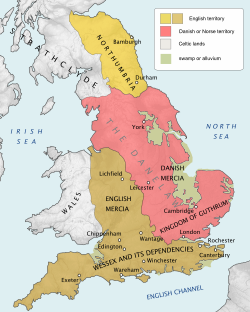
Eventually, it started to dawn on the Vikings that the British Isles had a better climate than Scandinavia, and they started to establish settlements there. They built the city of Dublin and other ports around Ireland,[42] and they settled minor islands across Scotland as well. They also started forming temporary alliances with different Anglo-Saxon kingdoms in order to set them against each other and undermine them.
In 865 CE, things escalated when a large Viking force, probably about 3,000 men,[41] arrived in Kent with the intention of outright conquering England. According to Norse sagas, the so-called "Great Heathen Army" was led by the heirs of the legendary Ragnar Lothbrok![]() , who wanted to avenge his death at the hands of King Ælla of Northumbria.[41] This probably wasn't the case, but we do know that the Great Heathen Army successfully pushed north and conquered the city of York, turning it into their home base.[41] From there, they gradually annexed the Anglo-Saxon kingdoms with the exception of Wessex. Wessex's king, Alfred the Great, was able to hold back the Norse tide by defeating them in a major battle in 878 CE.[43] The subsequent peace negotiations left the Vikings in control of central England and Alfred in control of the rest.
, who wanted to avenge his death at the hands of King Ælla of Northumbria.[41] This probably wasn't the case, but we do know that the Great Heathen Army successfully pushed north and conquered the city of York, turning it into their home base.[41] From there, they gradually annexed the Anglo-Saxon kingdoms with the exception of Wessex. Wessex's king, Alfred the Great, was able to hold back the Norse tide by defeating them in a major battle in 878 CE.[43] The subsequent peace negotiations left the Vikings in control of central England and Alfred in control of the rest.
The Danelaw[edit]
The regions conquered by the Norse are today known as the "Danelaw", and an estimated 20,000 to 35,000 Scandinavian people settled there over several generations.[44] Scandinavian settlers seem to have culturally assimilated fairly quickly[44], but they still left their cultural mark on the landscape. They left place names like Grimsby (meaning "farm/by of Grimr") and Scunthorpe (meaning "village/thorpe of Skuma).[43] If an English city name ends in "-by" or "-thorpe", it was probably founded or renamed by the Norse. They also left words, including the pronouns "they, their, them"[45] (greetings to our nonbinary readers) and verbs like "to take", "to crawl", "to guess", "to be", and "to trust".[45] Also on brand for the Vikings, the English words "slaughter", "ransack", "club", and "knife" evolved from Old Norse.[45] The Norse also fostered an urban culture in places like Lincoln, Stamford, Derby, Leicester and Nottingham by importing goods and fostering local industries.[43]
Unification of England[edit]
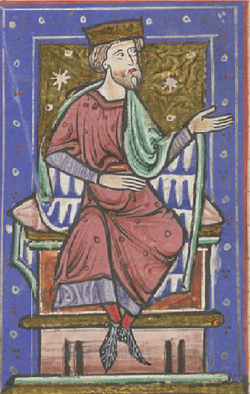
Meanwhile, King Alfred the Great of Wessex took the opportunity to reform his kingdom's army and construct fortified settlements called "burhs", which would house people fleeing from Viking raids.[46] He also implemented a modernized tax system and judiciary.[46] Probably the most important thing he did was establishing an education system for the nobility and even some commoners.[46] He took a major step towards the unification of England by merging Mercia into his realm through a political marriage.
Alfred died in 899, and his son Edward succeeded him. Edward faced competition from his cousin Æthelwold, who claimed the throne for himself and allied with Danelaw-controlled Northumbria in order to get an army for himself.[47] Pretenders to the throne and the problems they cause are one of the major problems of monarchy. Æthelwold's actions plunged Wessex back into war with the Norse and allowed him to reclaim much of Mercia's land from the Danelaw.[47]
King Æthelstan succeeded his father as King of Wessex in 924, and some political marriages had resulted in the Norse ruler of Northumbria being his brother-in-law.[48] When said brother-in-law died, the kingdom of Northumbria fell into Æthelstan. This massive stroke of luck turned Æthelstan into the most powerful man on the British Isles and the first king of a united England. Fearing his power, the king of Scotland, the petty kingdom of Strathclyde in northern England, and the Viking ruler of Dublin formed a coalition against him. This resulted in the 937 Battle of Brunanburh (don't even try to pronounce that), a bloody, day-long battle that shattered the coalition's forces and removed any doubt that Æthelstan would remain the King of England.[48]
Æthelstan went on to build on his father's and grandfather's achievements by promoting the English language and culture across his lands, patronizing English-language arts and literature, and centralizing power under the crown.[48] He died in 939, having completed the House of Wessex's journey from near-annihilation at the hands of the Danelaw to the founding dynasty of England.
Final years of the Anglo-Saxons[edit]
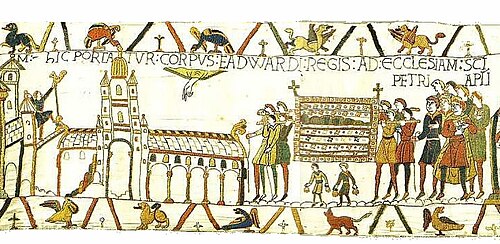
Things weren't going to go smoothly for England after this. In 978, the throne passed to Æthelred the Unready (which translates to Æthelred the Poorly-Counseled).[49] England's Viking enemies sensed weakness from the young king and began raids and invasions. In desperation, Æthelred ordered a huge massacre of all Norse people his forces could find in England during the year 1002.[49]
Across the North Sea, Scandinavia had been unified by Harald Bluetooth (yes, that Bluetooth[50]), who passed the throne to his son Svein Forkbeard.[49] The Vikings invaded England in 1013 and managed to fully occupy it, and Svein's son Knut became the ruler of the so-called North Sea Empire.[49] This cobbled-together realm fell apart in 1035, but the wars and occupation weakened England. The new king was Æthelred's son, who became known as Edward the Confessor due to his religious fervor. Edward's mother was Emma of Normandy, a fact which will become very relevant in the section below this. He is perhaps best known for beginning the construction of Westminster Abbey in 1042, a building designed in the Norman Romanesque style of architecture.[51] His reign was also marked by the rising power of English nobles, who were infuriated by the king's apparent favoritism towards the Normans who had accompanied his mother to court.[51] Chief among them were Godwin and his son Harold, the latter whom Edward named as his successor due to a lack of blood-related heirs.[51] Thus were the seeds of disaster sewn that would end Anglo-Saxon rule in England. Edward died in the year 1066, and all hell broke loose.
The House of Normandy (1066–1135)[edit]
.svg.png)
Arms of William I.
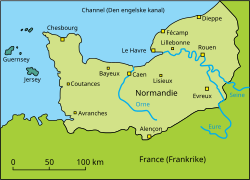
The Duchy of Normandy.

King William I.
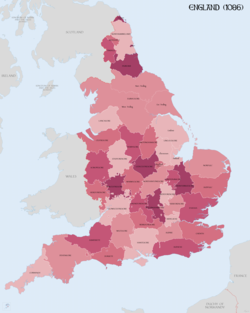
English counties in 1086.
The Norman Conquest[edit]

The day after Edward the Confessor died, the Witan (a council of high ranking nobility) elected Harold, son of Godwin as the new king of England.[52] But Harold was not ready for the amount of shit that was about to hit the fan.
The first major threat came from Normandy, a duchy on the northern coast of France that had been settled by Vikings in 911 with consent from the French crown.[53] Duke William the Bastard (he was born out of wedlock)[54] claimed that Edward had promised him the crown since he was related to Edward's Norman mother.[52] Fully intent on pressing that claim, William began putting together an invasion force.
Norway's king, Harald "the last Viking" Hardrada, also decided that Edward's death created an opportunity to seize England for himself.[55] Unluckily for him, Hardrada's army landed first, in Northumbria. He took the city of York, but Godwinson's army reacted with stunning speed, marching north in only 4 days and crushing the surprised Vikings at the Battle of Stamford Bridge.[56] Hardrada died in the battle.
The Normans landed days later in East Sussex, and their fresh troops fought the exhausted Anglo-Saxon army at the famous Battle of Hastings.[57] Godwinson was killed in action; most accounts claim he was struck by an arrow to the eye. Rough way to go.
With the old king dead and his army routed, William gradually fought his way through the remaining Anglo-Saxon resistance and had himself crowned as the King of England on Christmas Day, 1066.[52] He became King William the Conqueror, the first monarch of the House of Normandy.[58]
Norman oppression and societal changes[edit]
.jpg)
“”And so the English groaned aloud for their lost liberty and plotted ceaselessly to find some way of shaking off a yoke that was so intolerable and unaccustomed.
|
| —Orderic Vitalis |
The early years of William's reign were marked by the construction of castles across the English landscape, which was done in order to limit the impact of ongoing Anglo-Saxon rebellion. Among these new constructions was the infamous Tower of London, which William ordered built almost immediately to defend his royal capital.[60] These rebellions were exacerbated by William's policies of increased taxation and seizure of land from Anglo-Saxon nobles.[61]
Northern England saw more intense rebellions with the support and encouragement of Scotland and the remaining Norse in England. With the north too powerful to tame with the castles strategy, William led his forces into the region with orders to burn and destroy anything capable of sustaining human life in the year 1069.[62] His forces burned barns, salted fields, slaughtered animals, and ransacked villages and churches. William had a Christmas feast in York that year as the people of the region starved. The so-called "Harrying of the North" was militarily successful at halting the rebellions, but it caused a famine that killed as many as 100,000 people.[62]
In 1085, William commissioned the Domesday Book![]() , a massive survey to determine wealth and and assets of his subjects for the purposes of ensuring accurate taxation and assessing the state of the English economy post-Conquest.[63] Much of our modern knowledge of England during this period comes from the survey.
, a massive survey to determine wealth and and assets of his subjects for the purposes of ensuring accurate taxation and assessing the state of the English economy post-Conquest.[63] Much of our modern knowledge of England during this period comes from the survey.
William's economic actions had a lasting impact on English society. By confiscating land from Anglo-Saxon nobles and handing some of it out to his own loyalists, William further entrenched the system of feudalism across England and increased the crown's role in it.[64] According to his own laws, William personally owned all land in England. He kept 20% for his own personal use, gave another 25% to the Church, and he doled out the rest to Norman nobility and knights who had aided him in his conquest.[65] In exchange for land, the new noble class pledged eternal subordination and military support for the king. English peasants, meanwhile lived as serfs: both bound to the land and owing labor to the nobility for the privilege of continuing to live there.[65]
The effects of Norman rule on English culture were probably even more long-lasting. Norman nobility intermarried with Anglo-Saxon nobility, and the two cultures gradually merged.[59] Anglo-Saxons took Norman names (like William, Robert, Henry, Alice, or Matilda), as Anglo-Saxon names would mark one out as a member of the lower classes.[66] The Anglo-Saxon name Harold is to this day far less popular than the Norman name Henry. The Norman custom of giving people surnames was also adopted as well as the use of "Fitz-" as a prefix for those surnames.[66] The conquest also left its impact on the English language, as French Norman words were viewed as fancier and more respectable than Old English words. As Robert Bartlett, a historian at the University of St Andrews, said,[66]
“”Pig is English in origin, pork is French. Sheep is English, mutton is French. Cow is English, beef is French. When it's in a cold and muddy field covered in dung, it's named in English. When it's been cooked and carved and put on a table with a glass of wine, it's referred to in French.
|
Within 150 years, the entire English language had changed dramatically as the language was written more often during the Norman times, and therefore the Norman influence on the language was increasingly standardized. This is why Old English texts like the original Beowulf are incomprehensible to a modern reader.
.jpg)
Rochester Castle, built in the immediate aftermath of the Conquest.
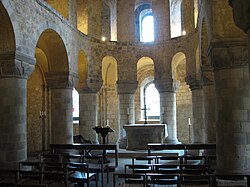
Chapel of St. John inside the White Tower.

Richmond Castle, built during the Harrying of the North.
.jpg)
Durham Cathedral, built between 1093 and 1133 (additions made in the 1400s).
Family: can't live with 'em, can't live without 'em[edit]

William the Conqueror died in 1087, and the confusing-ass Norman inheritance laws caused strife among his sons. William's oldest son, Robert, ended up with the Duchy of Normandy, while his middle son William II inherited the more prestigious Kingdom of England.[67] As you can imagine, Robert was pissed. The Conqueror's youngest son, Henry, was still a teenager, and he only received some cash.
Duke Robert and King William II predictably went to war, but they were interrupted in 1096 by the outbreak of the First Crusade.[68] Robert decided that the Holy Land was a more interesting place than England anyway, and he decided to participate. Back in England, William II was an entirely different sort. He was a fairly secular-minded ruler for the time, and he decided to raise money for the Crown by cutting allowances to the Church and even placing extra taxes on their monasteries.[69] Horrified by this behavior, Archbishop Anselm of Canterbury opposed the king and eventually had to go into exile.[69] Questions of how royal authority matched up to church authority would haunt the country for a long time after.
In 1100, William II died in a hunting accident while he was out with his younger brother, Henry.[68] Henry then became king. Totally not suspicious. King Henry I decided to earn some more "good sibling" points by invading Normandy, winning the ensuing war, and imprisoning Duke Robert for the rest of his life.[68]
Henry's later reign was marked by efforts to negotiate with the King of France, as the Duchy of Normandy was still de jure a French vassal.[70] He brought his son and heir, William Adelin, do do homage to the King of France in the year 1120, as King Henry refused to bow to a ruler who was his own rank.[70] William Adelin and his father then went home on different ships.[71] William Adelin's party embarked on the Blanche Nef ("White Ship"), where they promptly got shitfaced drunk.[70] Not wanting to be left out, the ship's crew got in on the fun too. They promptly ran the ship into a bunch of rocks off the French coast, and the disaster killed William Adelin and everyone else save a single survivor.[70] Remember kids, don't drink and drive.
The White Ship disaster caused immediate chaos in England, as King Henry was left without any legitimate heir and a bunch of other nobles had lost sons on the ship as well.[71] Henry decided that the throne would pass to his daughter, Matilda, but Norman law and sexist attitudes at the time made this very risky.[71] Henry's death in 1135 sparked an entirely predictable civil war.
The Anarchy[edit]
.jpg)
Famously the historical inspiration for HBO's House of the Dragon,[72] the Anarchy was a civil war that pitted the old king's daughter and chosen heir against a male cousin who claimed the throne for himself. Much of the nobility of England broke the vows they'd sworn in support of Matilda and had her cousin, Stephen of Blois, crowned in her place. Unfortunately, Stephen was a weak king whose affable personality was exploited by nobles who cheerfully began exploiting the peasantry and breaking laws.[73]
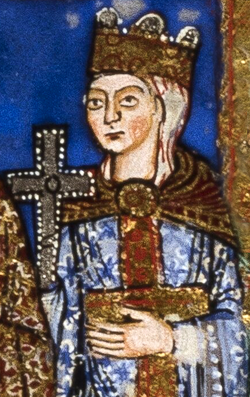
Matilda, meanwhile, was understandably pissed at having her inheritance stolen. She and her husband, Duke Geoffrey Plantagenet of Anjou, rallied their forces, and her army swiftly defeated Stephen's forces at the Battle of Lincoln in 1141 while Geoffrey invaded Normandy from Anjou.[74] Stephen fell into her hands, and she had him imprisoned. The nobility, though, hated her and chased her out of London because they thought she was a haughty bitch.[74] Considering the time period and what was expected from women, there's a good chance this wasn't true. But there's no good way of knowing. Stephen was released from prison, and the nobility turned the tables on Matilda by trying to arrest her, but she disguised herself as a corpse to escape. Matilda reestablished her forces in Normandy, and the brutal civil war carried on for over a decade. Between the violence and Stephen's feckless leadership, the crown lost control over the nobility. Nobles fighting their own wars amongst themselves and freely switched sides between the two royal factions.
The war was eventually passed down to Matilda's son Henry, who was now the Count of Anjou after Geoffrey's death.[75] He married Duchess Eleanor of Aquitaine, and between her lands, Normandy, and Anjou, Henry controlled almost half of France.[76] This meant he had far more resources to carry on the war for England.
The first signs that peace would break out came in 1153 when both his and Stephen's forces refused to engage in battle.[75] Many nobles had made peace among themselves and now expected Stephen and Henry to do the same. Their demands led to the 1154 Treaty of Winchester, in which Stephen appointed Henry as his heir.[75] Stephen promptly and conveniently died now that his role in the plot was over, and Henry became King Henry II.
The House of Plantagenet (1154-1399)[edit]
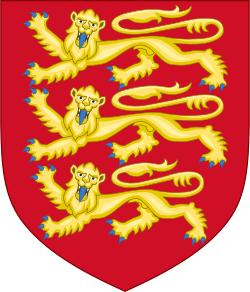
Royal arms of England, 1198-1340.

The Angevin Empire during Henry II's reign.
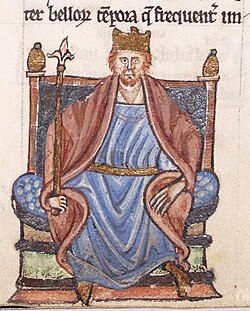
King Henry II.
.svg.png)
Royal arms of England during and after the Hundred Years War.
The Angevin Empire[edit]
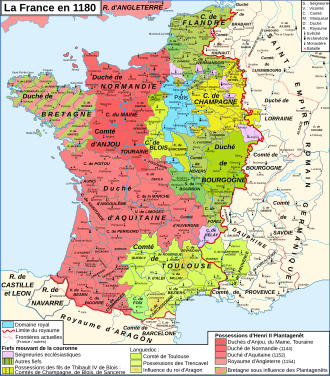
King Henry II, who named his royal house Plantagenet after his father's name, began his reign as the most powerful monarch in all of Western Europe. The so-called "Angevin Empire" takes its name from the County of Anjou, where the Plantagenet kings originated.[77] However, Henry never claimed the title of "emperor" and never would have since the Church held that the Holy Roman Emperor would be the only true Emperor of Catholic Europe. The king's first agenda was to reassert royal authority over the nobles, and he did this by revamping the legal system and ensuring that it was forbidden for any noble to construct a castle without royal agreement.[78] This mission ended up being far simpler than his other objective: asserting royal authority over the Church.

By naming his best pal Thomas Becket as the Archbishop of Canterbury (the highest-ranking clergyman in England), Henry II hoped to make the Church more agreeable and pliable.[79] The king was frustrated that his efforts to enforce common law was stymied by the Church's adherence to its own laws. A priest who committed murder or rape could claim "benefit of clergy" and be tried in a church court where the harshest punishment was expulsion from the priesthood.[79] The Church looked after its people, in other words. (A lot of that mindset survives in the Church to this day).
Becket's demeanor completely changed upon taking his new position, and he bought into the Church's teachings completely. He clashed with his old friend over the Church's privileges, and things escalated into a genuine screaming match with the king's supporters at Northampton Castle in 1164.[79] Thomas was exiled until 1170, but his relationship with the king didn't improve when he returned. Henry II bitched about Becket incessantly, saying at one point to his knights: "What miserable drones and traitors have I nurtured and promoted in my household who let their lord be treated with such shameful contempt by a low-born clerk!"[80] The shamed knights interpreted this as an order to kill Becket, and they busted into Canterbury Cathedral and hacked Becket apart with their blades. The murder appalled the Christian world, and the pope had Becket canonized as a saint and had Canterbury Cathedral recognized as an important holy place.[80]
The "empire" was beset by foreign threats as well. Henry II's sons opposed his plans to have the empire partitioned between them upon his death, and they rebelled in 1173 with support from Scotland (which hated him for claiming overlordship over them) and France (look at the map to see why they hated him).[78] The rebellion only lasted a year, but a humbled Henry II believed it had been punishment from God for playing a role in killing Thomas Becket.[78] Also, in 1169, Henry II ordered the invasion of Ireland, which drastically altered the island's fate.[81]
Let's fight more wars[edit]

In 1189, Henry II was succeeded by his son Richard, who is today known as Richard Cœur de Lion ("the Lionheart"). Richard had twice rebelled against his father, but Richard's demonstration of his martial skills impressed his father enough to have him designated as sole heir to the Angevin throne.[82]
Once he became king, Richard was preoccupied with taking part in the Third Crusade, and he emptied the Angevin treasury in order to raise an army and transport them to the Levant. Alongside Philip II of France, Richard famously warred against the Muslim sultan Saladin![]() over control of Jerusalem. Although he failed to take the city and ordered the massacre 2,500-3,000 Muslim prisoners, Richard's feats made him into an English legend.[82] In the end, Richard signed a treaty with Saladin ensuring that Christian pilgrims would be granted safe access to the city's holy sites. England's participation in the Crusades also inflamed religious animosity towards the country's Jewish population, and in 1190 one of the worst pogroms of the entire Middle Ages took place in York.[83]
over control of Jerusalem. Although he failed to take the city and ordered the massacre 2,500-3,000 Muslim prisoners, Richard's feats made him into an English legend.[82] In the end, Richard signed a treaty with Saladin ensuring that Christian pilgrims would be granted safe access to the city's holy sites. England's participation in the Crusades also inflamed religious animosity towards the country's Jewish population, and in 1190 one of the worst pogroms of the entire Middle Ages took place in York.[83]
On his way back from the Crusade, the Holy Roman Emperor had him imprisoned in Austria for two years as retaliation for an insult.[82] In 1194, after having spent a short time in England, Richard went to France to war against his former Crusader ally Philip II, who was pissed that Richard didn't marry his sister Alice despite being engaged for 20 years.[82] Richard died in 1199 from a mortal wound, having spent barely any time in England.
King John and the Magna Carta[edit]
.jpg)
Richard had been more busy warring than anything else, so he lacked heirs. The throne passed to his younger brother, John, who is today remembered as perhaps the worst king in English history. Upon taking the throne, John set aside his first wife and married Isabella of Angoulême (a county in Aquitaine), which pissed of King Philip II of France since Isabella had been promised to a French noble.[84] War broke out, but John wasn't good at waging war or making friends among the French nobility. Philip II advanced John's nephew Arthur as a claimant for the English throne, so John decided to make his nephew "disappear" in 1203.[85] This only made things worse, as John was now denounced as a kinslayer and many nobles defected to support Philip's redoubled war effort. Things went poorly for John, and he managed the impressive feat of losing Normandy and all of England's land in France except for Aquitaine by the year 1206. Desperate to turn things around (and stop people laughing at him), John hiked taxes on the nobility and reduced their privileges in order to pay for more war against France.[84] The nobles reacted to this pretty much how you'd expect, and even the Church was pissed at him by this point.
When John's army lost the decisive 1214 Battle of Bouvines in France, the nobles revolted and stormed London. The king finally agreed to negotiate, and discussions resulted in the creation and signing of the Magna Carta in 1215, a document that sought to limit the king's power. Under the terms of the Magna Carta, the king could no longer seize lands arbitrarily or impose high taxes without first consulting the nobility, the king would have to consult a defined body of laws and customs before making declarations, and all free men would have the right to a fair trial.[84] Although he signed it, John immediately convinced the pope to annul the document on the basis that it was signed under duress. The infuriated nobles rebelled again with the intention of putting the French Prince Louis on the throne, but King John managed to escape this situation by dying in 1216.[84] Although annulled, the ideals of the Magna Carta remained influential and far outlived the hapless king who signed it.
Development of English governance[edit]

King Henry III took the throne at the age of 9, and with that position came the trials of the First Barons' War that had been started by his father's irresponsibility. While the crown generally did well in the war, Henry III's regents decided to reinstate parts of the Magna Carta in order to bring the infighting to an end.[86] They then reissued the entire Magna Carta in 1225 in order to rally support for another war against France.
In 1258, Henry III implemented yet another reform in response to criticism that he was handing out too much responsibility to his own family and French-speaking loyalists. He started to frequently call the nobility into meetings called "parliament" in order to win their support for new taxes and new government activities.[87] The king's reluctance to truly hold himself to this new parliament idea led to the outbreak of the Second Barons' War in 1264, which resulted in Henry III's imprisonment and an agreement to renew the crown's commitment to the Magna Carta.[86] "Ugh, fine, I guess we'll do this limited authority shit." Henry III died in 1272, his reign having been largely unsuccessful.
Conquering Wales and hammering the Scots[edit]
.jpg)
Ever since 1066, England had harbored the ambition of conquering Wales, and its kings had made abortive attempts to do so. Although Wales was a small country, it was extremely mountainous, and England was up to this point unable to occupy it save for a strip of land in the south. This is the situation that Henry III's heir Edward faced when he returned to England from the Crusades in 1274. After Edward's coronation, he removed the crown and swore that he would never put it back on until he recovered England's rightful land.[88] In other words, England's neighbours were about to have some major problems.
Edward invaded Wales in 1277 after exacerbating a succession issue there, and he took advantage of political divisions in Wales to win support from many Welsh lords.[88] The English promptly mistreated their new Welsh subjects, and Edward had to return to crush a rebellion in 1284. The king repealed Welsh laws to be replaced with English ones, reorganized Wales into new counties, and built castles across the landscape to defend against any further rebellion.[88] In 1301, he named his firstborn son and heir as the Prince of Wales, a tradition that English monarchs follow to this day.[89] Unfortunately for Edward, conquering Wales cost a shitload of money. Edward decided to solve this problem in 1290 by issuing the Edict of Expulsion, which kicked Jews out of England and had their property confiscated by the Crown.[88] Medieval problems require Medieval solutions.

Also in 1290, Edward turned his attention to Scotland. This is a good time to note that his tomb is painted with the words Scottorum malleus ("Hammer of the Scots").[89] Scotland lacked an heir to its throne, and its lords invited Edward to come mediate the dispute, since England had the wealth and power to enforce the decision over whatever infighting would ensue. In exchange for that service, Edward demanded that the Scottish lords recognize him as having "sovereign lordship of Scotland."[89] Edward picked John Balliol to be king of Scotland, but he promptly undermined Balliol by summoning him to Westminster and insisting that England could hear appeals to Balliol's decisions.[89]

These humiliations were too much for Scotland to bear, so the Scottish lords deposed Balliol in 1294 and formed an alliance with France against England. Edward, enraged, quickly launched a destructive invasion of Scotland, imprisoned Balliol for the rest of his life, and took control of most of Scottish territory.[89] His efforts included the brutal massacre of the Scottish city of Berwik.[90] This led to the famous rebellion by William Wallace, which ended in 1305 with Wallace's execution.[91]
In 1306, Robert the Bruce, who was the opposing claimant to John Balliol, declared himself the King of Scotland and rebelled against Edward. He suffered major defeats at the outset of his rebellion, and the loss of his military strength reduced him to the status of an outlaw.[90] Bruce changed to guerrilla tactics that benefited from the mountainous terrain of Scotland, and he rebuilt his strength to the point where he won the decisive Battle of Bannockburn in 1314.[90] Edward I, meanwhile, had died in 1307, and his son Edward II was a weak ruler who wasn't up to the task of reigning in Scotland. The war ended in 1328 with Scotland's independence preserved.
Oh boy, it's time for the Hundred Years War[edit]
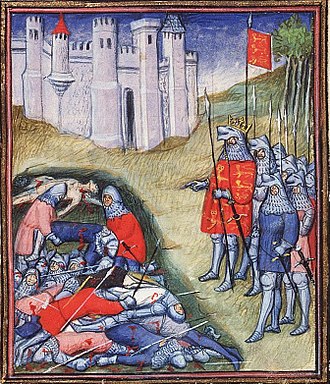
Edward II was a thoroughly mediocre king, but he did make a major historical decision: marrying Isabella of France, daughter of King Philip IV. After being deposed by his wife and her French lover, Edward II was imprisoned and murdered in 1327.[92] Upon his rise to power, the young King Edward III had his mom tossed in prison and her lover executed as a traitor.
Although Edward clearly had no deep affection for his mother, he did appreciate the fact that her bloodline granted him an extremely strong claim to the French throne. When Philip VI died, he was succeeded by his cousin Charles IV, even though Edward III was actually more closely related to him.[92] The French discounted Edward III's claim since he was basing it on his mother's bloodline, but what mattered was that Edward III had the money and resources to press his claim through war. He quartered the royal arms of England with the golden fleur-de-lis of France (see the image at the top of the Plantagenet section), had himself crowned as the King of France, and began the war in 1337.

Edward's forces pushed through Gascony in southern France, and the king himself invaded and pillaged French-controlled Normandy. Edward's actions finally forced Charles to meet him on the field at Crécy in 1346, a battle which ended in a massive victory for the English due to their defensive tactics.[92] Charles called on Scotland to help him, but the Scottish invasion of England went poorly. Warfare was interrupted by the Black Death at this point, but conflict resumed in 1350 under the control of Edward III's son, known as Edward the Black Prince. The Black Prince captured the newly-crowned John II of France, but he was known to the French locals as a merciless pillager and destroyer.[92]
A brief peace ensued in 1360, but the accession of King Charles V of France renewed hostilities. The new Charles changed strategies by adopting guerrilla tactics similar to how the Scottish had fought during their earlier war for independence, and Edward III had no answer to this.[92] He was also struggling to find the funds to pay for this ruinously expensive war. The English king's monetary problems forced him to compromise more and more with his own realm's dignitaries as the English Parliament further took shape as an institution.[92] Edward III died in 1377, and his son, the Black Prince, had died before him. Both left behind a war that was proving to be far more difficult than they'd envisioned.
Richard II, son of the Black Prince, took the throne, and he was immediately confronted with the Peasant's Uprising in 1381. Peasants demanded removal of the cap on labour wages, redistribution of the Church's wealth, and the total abolition of serfdom.[93] Richard took the easy way out by just crushing them militarily, but some of the peasants' demands were slightly realized. Confident after this victory, Richard proved to be a very bad mix of both arrogant and weak. He was an unpopular monarch who managed to piss of the nobility enough that they rallied behind his cousin, Henry Bolingbroke the Duke of Lancaster, in a rebellion to place Henry on the throne.[94] He was defeated and forced to abdicate in 1399, and Henry's rise to the throne brought the House of Lancaster (a cadet branch of the Plantagenets) into power.
The House of Lancaster (1399-1461/71)[edit]

Arms of the House of Lancaster.
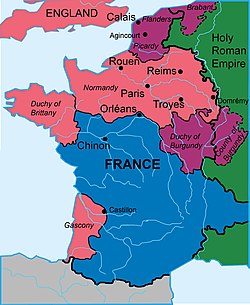
English holdings in France, 1429.
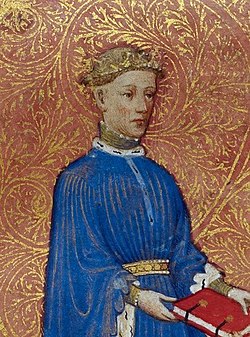
King Henry V.
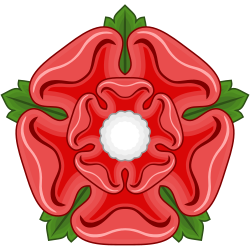
The heraldic badge of Lancaster.
Trouble on the home front[edit]
The newly-crowned King Henry IV had no honeymoon period; Wales and various English earls rebelled in 1400 with assistance from French troops.[95] Parliament was distinctly not impressed with the king's failure to deal with this issue, and they remained assembled as the first "Long Parliament" through 1406. Henry IV finally suppressed the rebellions in 1408, but he only got to enjoy it until his death in 1413.
Complicating matters during this time was the rise of the Lollards. These were a group of heretics who followed the teachings of John Wycliffe, a theologian who advocated against the Catholic Church's wealth and corruption.[96] The Church censured Wycliffe several times, but it was only in 1415 after his works inspired the more influential reformist movement of Jan Hus in Bohemia that the Church had Wycliffe posthumously branded a heretic.[97] The Church had Wycliffe's remains dug up and burned, and it ordered the English Crown to persecute the Lollards.
The Hundred Years War continued[edit]

Henry V is unarguably the most famous Lancaster king. During his time as a prince, he led his father's armies against rebels in Wales, an experience that shaped him into a martial enthusiast. He wanted to take a more intense and militaristic approach to the ongoing conflict in France. When he rose to the throne in 1413, he started promoting the English language over the French, and he also intensified the Crown's persecution of the Lollards.[98] However, he is best known for invading Normandy and winning a massive victory at the Battle of Agincourt in 1415.[98] Henry also benefited from the French Duchy of Burgundy turning its back on the French crown. So badly damaged was the French war effort that France was forced to sign a treaty making Henry V the heir to the throne and acknowledging English territorial gains.[99] Henry V missed his chance to take the French throne, though, as he died young of dysentery in 1422.
Henry VI took the throne as an infant, and his regents were unable to stop the French resurgence led by the ambitious Charles VII and the famous peasant girl Joan of Arc. The two of them put France back on the offense, and this trend could not be reversed even after Joan's capture and execution.[99] France just had too many men and resources compared to the English. For his part, King Henry VI had little interest in continuing the war, especially after the French retook Paris in 1337.[100] He attempted to make peace in 1444 by returning the County of Maine and marrying Margaret of Anjou, but these actions only damaged his credibility with the English nobility.[100] In 1453, the French retook the Duchy of Gasony, the last remaining major English holding in France.[100] Thus ended the Hundred Years War, but the seeds of further disaster were planted in England.
The House of York (1461/71-1485)[edit]

Arms of the House of York.

England during the Wars of the Roses. Yorkist regions in blue.
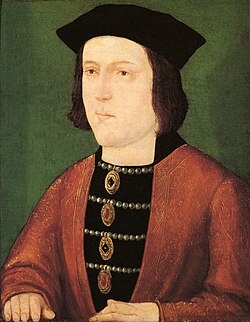
King Edward IV.
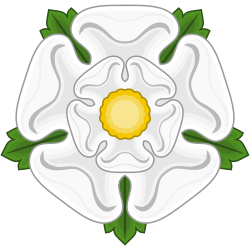
The heraldic badge of York.
The Wars of the Roses[edit]
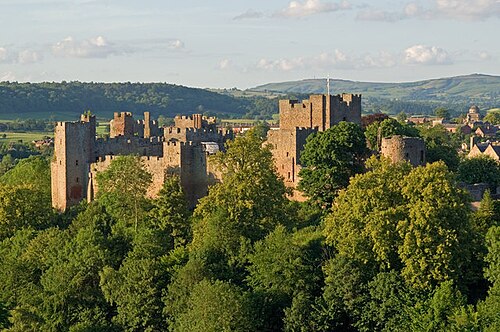
Almost immediately after suffering total defeat in the Hundred Years' War, Henry VI had a mental breakdown and became unfit to rule.[100] In the English court, nobles who wanted peace were opposed by Richard, the Duke of York, who wanted to take the reins of government and keep fighting France.[101] He also had a strong claim to Henry's throne, being a direct descendant of King Richard II, and he was also the richest man in England.[102] York's ambitions were noticed by Queen Margaret, and he was forced from court. However, York rallied his own armies and marched on London in 1455 with the stated goal of removing the incapacitated king's advisors.[101] This began the Wars of the Roses.

After five years of war, Richard of York managed to capture King Henry VI in battle, forcing a peace settlement that acknowledged him as Henry's heir. He died in battle shortly thereafter, as Queen Margaret refused to see her son disinherited and rebelled against the peace.[101] His son Edward, though, was a skilled commander despite being only 18. He also benefited from the fact that Queen Margaret had sought military resources from Scotland, as the people of London and much of England weren't thrilled by the idea of a French Queen leading a Scottish army wanting to tell them what to do. This convinced Parliament to back Edward, and he was crowned as King Edward IV in 1461, the first King from the House of York.[102] He then defeated the Queen's forces at the Battle of Towton at the cost of about 28,000 lives.[103]
Henry VI was captured in 1465, but Edward IV's squabbling with his own backers (he wanted to marry for love instead of someone they wanted) convinced them to depose him and restore Henry in 1470.[104] This only lasted a short while, as two Yorkist victories in battle resulted in the death of Henry VI's son and the capture of Queen Margaret.[104] This put Edward IV back on the throne in 1471, and Henry VI promptly died in the Tower of London (we all know what really happened).[104]

The war seemingly ended here, and it might have had Edward IV not died in 1483. His son, now King Edward V, was only 12 years old, while his brother Richard was an ambitious adult. Richard had Edward V tossed in the Tower, and the young king disappeared. The popular assumption was that the kid was murdered, and this was apparently confirmed when King Richard III was crowned later in 1483.[102] This crime horrified the nobles of England and revived the Lancastrian cause, now under the leadership of Henry Tudor. Tudor only had a distant relation to the House of Lancaster, but he was the best the Lancastrians could hope for since all other heirs for the cause were dead. With help from French mercenaries, Tudor defeated and killed Richard III at the Battle of Bosworth Field in 1485. Since Richard III died heirless, Henry Tudor was crowned king shortly thereafter, and he married Elizabeth of York in order to unite the two factions.[102] Except for a short rebellion in 1487, the Wars of the Roses had ended.
While the war is said to have had relatively little direct impact on the commoners, it gutted many noble houses.[102] This had the effect of transferring power and land to the Crown. Memory of the wars also haunted the country for a long time thereafter; nobles and commons alike were horrified by the concept of civil war.[105] More recent historians have also reassessed the impact of the war on the commons, pointing out that roving armies at the time left trails of devastation behind them as they drained resources and pillaged villages.[105]
The House of Tudor (1485–1603)[edit]
_Variant.svg.png)
Royal arms of England during the Tudor dynasty.

England during the reign of Elizabeth I.
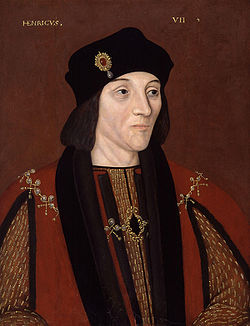
King Henry VII.
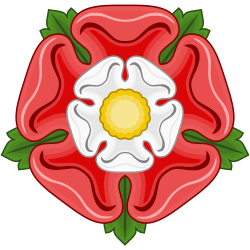
The heraldic badge of Tudor, combining the White and Red Roses.
Centralizing royal authority[edit]
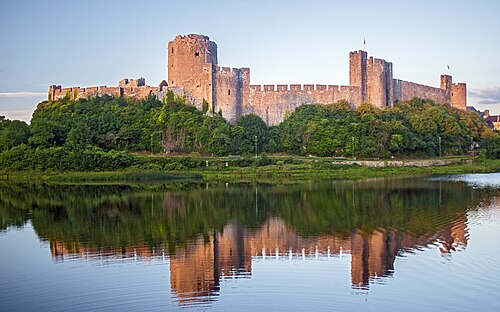
Henry VII's claim to the throne was embarrassingly slim, and he had to deal with pretenders rising against him frequently. Although Henry defeated the pretenders and successfully purged the remaining Yorkists, he spent the rest of his reign searching for and implementing methods to increase the Crown's control over the English nobility and people. Henry placed nobles he knew were loyal in charge of various regions of the country and took measures to confiscate positions from anyone who lost his trust.[106] He also enhanced the authority of the Justices of the Peace, who were royal officers appointed by the king to enforce the legislation he had passed.[106] He liked Justices of the Peace since they had to be loyal to him rather than the nobles of the regions in which they operated. He also rarely called Parliament into session.[107]
He also repaired the Crown's finances through the imposition of harsh fines on any nobles who stepped out of line; he combined this with a penal bond or "recognisance" that would allow him to confiscate property from and ruin anyone who failed to pay these fines.[108] Henry VII made money from punishing his nobles, and the recognisance policy allowed him to eliminate some from political life completely, further increasing his power. A pretty smart racket. Meanwhile, the king signed trade agreements with Denmark, the Netherlands, Spain, Portugal, and Florence, which brought even more money into the Crown's coffers.[108] His one major foreign war, to intervene in France's effort to annex Brittany, resulted in him being bribed off with another giant sack of cash.[108] Considering the state of the Crown when he inherited it, Henry had turned a pile of garbage into a pile of gold.
In 1501, Henry VII's heir Arthur and the Spanish princess Catherine of Aragon married, an agreement that Henry hoped would bind England to the increasingly powerful Spanish monarchy.[109] Arthur died almost immediately after, robbing us of an actual King Arthur. Henry VII then passed Catherine on to his younger son Henry with permission from the Pope. Other marriages he arranged bore diplomatic fruit as well. His daughter Margaret married King James IV of Scotland, and his other daughter Mary became the Queen of France.[108] When Henry VII died in 1509, he left behind a kingdom that was financially secure and respected abroad. His son, who became King Henry VIII, was a popular and athletic young man, and surely England's period of peace and stability would continue.
Henry VIII and the English Reformation[edit]

In case the ironic tone of that last sentence in the above section didn't clue you in, England did not continue its period of peace and stability under his reign. Henry VIII embarked on repeated wars with France between 1512 and 1526.[110] But the first signs of big trouble ahead in his reign were his repeated failures to produce an heir with Catherine, as all of their children but one girl (Mary) died in infancy.[111] An heir was deadly serious business, considering the clusterfuck that was the Wars of the Roses. Henry decided that all of this was obviously Catherine's fault since she had been his brother's wife, and he asked Pope Clement VII to sanction his divorce from Catherine. Well, too bad then that the Pope was beholden to Charles V the Holy Roman Emperor, who just so happened to be Catherine's nephew.[112]
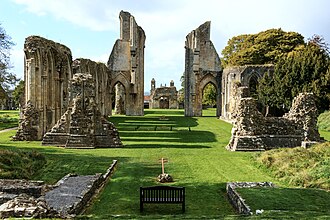
Refusing to take this without a fight, Henry VIII had Parliament pass the Act in Restraint of Appeals in 1533, declaring that the King had final say in England's religious matters rather than the Pope.[113] Thomas Cranmner, the Archbishop of Canterbury, then obliged the king's wishes and annulled his marriage with Catherine.
Henry VIII promptly married Anne Boleyn, a young woman who had caught his eye.[114] They had a girl, Elizabeth, soon after. Poor Catherine was taken away from her daughter Mary and moved around the realm into different castles.[111] Parliament rammed through more laws to enforce the realm's new religious direction. The 1534 Act of Supremacy declared that Henry VIII, as England's monarch, was the head of the Church of England, and the Treason Act made it illegal to criticize the king's actions.[113] Sir Thomas More, previously the king's right-hand man, was executed in accordance with this law for speaking out against the king's new marriage.[115] In 1536, Henry VIII began the Dissolution of the Monasteries, which shut down Catholic monastic estates and confiscated their wealth for the Crown's use.[116] This sparked widespread revolts, especially in the north where the influence of the monasteries was stronger.[116]
The king also ended up being just as much of a shitbag to Anne Boleyn as he was to his first wife. After Boleyn failed to give him a son, the king became convinced that she was adulterous and had her executed on trumped-up charges in 1536.[117] He married Jane Seymour the same year, but she died in childbirth giving him his coveted male heir, Edward.[117] Then he married Anne of Cleves in 1540 before amicably divorcing her, and then Katherine Howard in 1540, who he had beheaded in 1542.[117] His final wife was Katherine Parr, married in 1542. By now morbidly obese and with an ulcerated leg, Henry died in 1547, leaving her as his widow and one of only three women to survive being married to him.[111] England was now an impoverished and divided kingdom.
Religious chaos[edit]
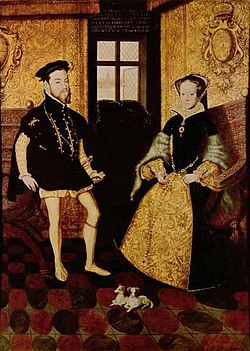
Edward VI, Henry VIII's son by Jane Seymour, was only 9 when he took the throne, so his uncle Edward Seymour served as his regent.[118] Seymour was a supporter of the English Reformation, although his first act was having the Treason Act amended to allow for free religious discussions again.[118] He further reformed the Church of England by allowing priests to marry, replacing altars with communion tables, mandating that Church services be conducted in English, and issuing a Book of Common Prayer in 1549.[118] By doling out lands confiscated from the Catholic Church, Seymour bought the loyalty of England's nobility despite religious revolts breaking out across the country.
Seymour was succeeded by John Dudley, the Earl of Warwick, in 1552 after Seymour came down with a bad case of getting beheaded, and he had a new Book of Common Prayer issued that fully rejected many Catholic doctrines.[118] He also implemented policies to crack down on English Catholics. The unlucky young king caught both measles and smallpox, though, and on his deathbed he followed Dudley's advice in appointing his cousin Lady Jane Grey as his heir.[118] Grey was both a Protestant and Dudley's daughter-in-law.
When Edward died of his illnesses in 1553, these plans went awry when Mary suddenly reappeared to remind everyone that she was Henry VIII's daughter with Catherine of Aragon. Despite being a firm Catholic, Mary had the support of most of England due to her superior claim and her army swept aside Dudley's forces. After her coronation, she had Dudley executed and Jane Grey confined to the Tower of London.[119]
Queen Mary was determined to drag England kicking and screaming back into the embrace of the Catholic Church. She married Prince Felipe of Spain and forced Parliament to accept him as her co-ruler.[120] This proved to be a very complicated ambition. While most of the commoners were indifferent to the religious debate, Mary's attempts to restore confiscated land to the Church provoked outrage from the nobles who now held much of that land.[119] Her marriage to Felipe was also unpopular due to England's recent hostile relations with Spain and knowledge of Spain's atrocities in the New World.[119] Fears of a Spanish occupation grew, and a major rebellion in 1554 resulted in a battle within London itself. Her religious policies, which included a total repeal of King Edward VI's religious reforms, were unpopular.
During her reign, Queen Mary had more than 280 Protestants burned at the stake, earning her the nickname "Bloody Mary".[120] However, execution was a last resort for Mary, as she preferred not to make people into martyrs. She also established a formal education system to train a new generation of Catholic clergy, and her economic policies were generally a major improvement over her two predecessors.[120] Mary died of stomach cancer in 1558, leaving behind no heirs, so her half-sister Elizabeth succeeded her as queen.
Elizabeth I and the rise of England as world power[edit]

Crowned at the age of 25, Elizabeth I would go on to be one of the most consequential monarchs in English history. At her order, Nicholas Bacon, the Lord Keeper of the Privy Seal, opened the queen's first Parliament by banning name-calling and religious insults.[121] Unfortunately, this didn't last too long, but it was a nice thought and a signal of the new queen's intentions. Between 1558 and 1563, Elizabeth pushed through laws meant to establish a middle-of-the-road approach to religious affairs. Although Elizabeth reestablished herself as the head of the Church, she ensured that Anglicanism would maintain many Catholic traditions and ensured that the new Book of Common Prayer would not be as radical as the 1552 version.[122] As an observing French diplomat put it in 1597, "apart from the absence of images, that there is little difference between their ceremonies and those of the Church of Rome."[122] On the flipside, attendance in Anglican churches was made mandatory (enforceable by a fine) and Catholic masses were banned (enforceable by execution).[122] More extreme Protestants were left largely undisturbed.

In secular affairs, Elizabeth notably had little interest in conquering land from France or Scotland, nor did she spend money as readily as her predecessors.[123] She also refused to marry, but her father was fucking Henry VIII, so that makes sense considering how he treated his wives. Elizabeth's reign saw English assistance to the Protestant Dutch during the Eighty Years War and fended off a plot to put the Catholic Mary, Queen of Scots![]() on the English throne (Scotland was now going through its own Reformation-related turmoil).
on the English throne (Scotland was now going through its own Reformation-related turmoil).
.jpg)
The pope excommunicated Elizabeth in 1570 (not that she gave a shit),[122] and Anglo-Spanish relations deteriorated to the point of war, leading to the storied defeat of the Spanish Armada in 1588.[125] England's victory against a far superior naval power was hailed as a sign of God's favor for Anglicanism, and it emphasized the importance of the English navy. William Shakespeare also rose to prominence during Elizabeth's reign, and his propagandist historical plays like Henry V further contributed to a sense of English nationalism.[123]
Probably her most important policies, Elizabeth began England's first major steps towards becoming a colonial power. She established charter companies, giving them a royal monopoly on trade and colonization in specific regions.[123] Elizabeth granted Sir Walter Raleigh rights to colonize the eastern coast of what would become the United States, leading to the creation of the first English colony, Roanoke (in modern Virginia), in 1585.[126] The colony soon failed, but English maintained an interest in the region. England also joined the slave trade and began sending exploration fleets across the world.
Elizabeth died in 1603 without children and during a major economic depression,[123] but her reign laid the foundation for the rise of England as a major world power.
The House of Stuart (1603-1649)[edit]
.svg.png)
Royal Arms of England during the Stuart dynasty.

England and Scotland united.

King James the VI and I (we'll explain).
.svg.png)
Royal arms of the Kingdom of Scotland (from 1603).
Colonialism, tobacco, and the divine right to rule[edit]

Elizabeth died heirless, so her closest relative, King James VI of Scotland, assumed the English throne as King James I (the sixth of his name in Scotland but the first of his name in England). For the first time, England, Scotland, and Ireland were all ruled by the same monarch. As King of Scotland, the devoutly Protestant James VI had aligned himself with his fellow Protestant neighbor to the south, making it relatively simple for him to take the English throne later.[127] Although the English court considered him scandalously informal, James I proved to be a capable head of state when he quickly brought England's ongoing war with Spain to an end in 1604 and maintained religious peace (with the exception of the infamous Gunpowder Plot of 1605).[127] The king was also responsible for the 1611 King James Version, a translation of the Bible, and he had an enthusiasm for hunting witches.[128]
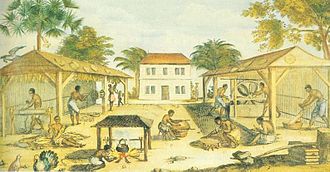
Major steps occurred for English colonialism, with the 1607 establishment of Jamestown colony,[129] and the voyage of the Mayflower to found Plymouth Colony in 1620.[130] While establishing these early colonies, Sir Walter Raleigh and other Englishmen noticed that the Native Americans had a habit of "drinking smoke" and decided to try it for themselves.[131] They decided that this new habit was pretty cool, and thus began the tobacco craze, which spread to England's royal court and then across Europe. English colonist John Rolfe visited the king personally with his wife Pocahontas to introduce the plant, and by 1630, tobacco had turned the previously unprofitable Virginia colony into a cash crop export machine.[131]
At home, the big problem during James I's reign was politics. James I ardently believed that he was God's lieutenant on Earth, as he explained in his manifesto The True Law of Free Monarchies, and he resented Parliament's attempts to restrain him.[132] James furiously fought Parliament, dissolving it in 1611, deadlocking it in 1614, and dissolving it again in 1621.[127] In retaliation, Parliament shot down the king's attempts to unite England and Scotland into a single nation.
King James died in 1625, but his successor Charles I had inherited his father's views on the divine right of monarchs. His reign got off to a bad start, with mishaps occurring during his coronation and military defeats against Spain and France taking centre stage during his first years.[133] Charles' clashes with Parliament were even worse; he repeatedly dismissed and recalled them, perhaps to annoy them into doing what he wanted. He agreed to the 1628 Petition of Right, which expanded Parliament's authority, but he promptly ignored it.[134] This pissed off Parliament even more and fully set England on the road to civil war.
The English Civil War[edit]
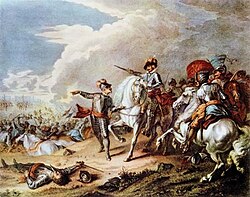
By 1642, Charles I, having largely ruled without Parliament, had nearly bankrupted the realm, surrounded himself with corrupt yes-men, and pissed off a huge portion of the nobility and clergy by trying to reintroduce more Catholic beliefs into Anglican doctrine.[135] In 1642, Charles I tried to storm into Parliament to arrest 5 MPs, but this only caused matters to deteriorate further.[135] Civil war began the same year.
Charles I was a competent battlefield commander, but Parliament had a more professional fighting force and more resources, as well as an alliance with Scotland.[136] Parliament also had a skilled commander in one Oliver Cromwell, who distinguished himself in battle and effectively took control of the Parliamentarian cause. In 1646, Scotland captured Charles I and handed him over to Parliament, but Charles refused the demands for a constitutional monarchy and tried to escape.[137] His continuing plots against Parliament convinced them to have him executed in 1649, ending the House of Stuart (for the time being, but spoilers).
The civil war left behind a ravaged country; England suffered 200,000 deaths, a greater proportional loss of life than it suffered in World War I.[136] Non-combatants had to endure greatly raised taxes as well as abuses at the hands of roving armies of soldiers (which included destruction of property, theft of food, and forced labour).
The Protectorate[edit]
.svg.png)
In 1653, after some abortive attempts at forming a republican government, Oliver Cromwell was declared Lord Protector of a united Commonwealth.[138] Effectively a military dictator, Cromwell tried to enforce his strict Puritan beliefs on the British people, although he notably left the colonies alone. Cromwell banned fun things like the celebration of Christmas (it was to be a day spent in church only), theatres, sports, dressing fancily, and doing literally anything but going to church on Sundays.[139] How dreary. In terms of foreign policy, Cromwell's rule also saw wars with Spain and the Netherlands.
Perhaps his most lasting legacy, Cromwell was bound to a decree that he had to receive a majority vote from the Council of State should he wish to call or dissolve Parliament, establishing a precedent that remains in force for English monarchs.[140] He died in 1658, and the office of Protector passed to his son, Richard. But his son lacked the respect and prestige of his father, and the Protectorate swiftly collapsed around him.
The remaining royalists in England plotted and succeeded in returning Charles I's son (also named Charles) to the country in 1660, as the English public were very tired of Cromwell's religious decrees by now. The new Charles made some smart political moves by promising to pardon most of those who fought against his father in the civil war, and he also pledged to allow freedom of religion and rule in concert with Parliament.[141] Parliament accepted this arrangement, and Charles Stuart was crowned as King Charles II in the same year.
Stuarts back in the saddle (1660–1688)[edit]
More political conflicts and more colonialism[edit]

Charles II's reign was marked by the king's interest in science (he established the Royal Observatory and Royal Society), more trade wars with the Netherlands, and initial good feeling with Parliament. However, tensions lurked beneath the surface. The English Civil War and the Puritanical reign of Cromwell had torn open the religious fabric of England, and the King disagreed with Parliament's desire to harshly enforce Anglicanism.[142] For the moment, though, the Stuart Restoration was proceeding relatively peacefully.
The more interesting things were happening abroad. Charles had married a princess from Portugal, and he recieved lands in India and Africa as part of the dowry.[142] In 1663, he granted permission for some nobles to settle the region of "Carolina" in North America, and in 1667, England took control of what is now New York City from the Netherlands.[142] The Virginia colony, meanwhile, was undergoing a transformation. It previously relied on importing indentured servants from England, who were treated very poorly,[143] but a crisis caused in part by socioeconomic tensions among the servant and poor classes sparked a rebellion in 1676.[144] Virginia and other colonies thus decided to rely more on African slave labor instead, and new laws codified a race-based hierarchy by declaring that children born to an enslaved mother would also be slaves.[145] Other English colonies followed suit, and English America became a slave society.
Charles II died in 1685, and his younger brother succeeded him as King James II. The domestic political scene turned ugly again, as James was a devout Catholic married to a Catholic wife. He earned enmity by dismissing Parliament without leave, placing Catholics in important positions, and enacting pro-Catholic policies unilaterally.[146] Things reached a breaking point in 1688, when some nobles started trying to invite the Dutch Protestant Prince William of Orange to England in the hopes that he could either talk some sense into James II or replace him entirely.[147] William had legitimacy because he was married to James II's daughter Mary, who was a Protestant.
While William put together a Dutch fleet, James II's supporters deserted him. When William departed for England, James II ignominiously fled the city and tossed his Royal Seal into the Thames River, which was popularly interpreted as an abdication.[147] Parliament recorded his abdication and allowed William and Mary to be crowned as joint monarchs of England, completing a process popularly known as the "Glorious Revolution".
The House of Stuart and Orange (1669-1707)[edit]
.svg.png)
Royal arms of England during William III's reign.
.jpg)
King William III.
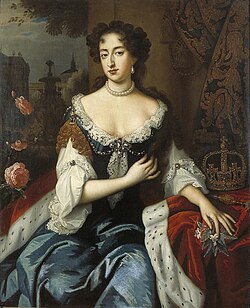
Queen Mary II.
.svg.png)
Arms of the Netherlands.
A constitutional monarchy[edit]
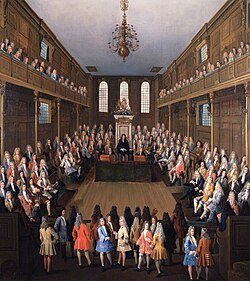
In exchange for his new kingdom, William III had to accept some strict limitations on his power. Firstly, he was crowned alongside his wife and could only rule as her co-monarch. Secondly, he immediately had to sign the English Bill of Rights, which stated that the king could not censor Parliament, impose excessive fines or cruel punishment on his subjects, or prevent Parliament from meeting or shooting down his laws.[148] The document also confirmed that Parliament had final authority on taxation. William later lamented in private that "Truly a King of England… is the worst figure in Christendom."[149]
Further restrictions followed. Only Parliament had the authority to declare war, only Parliament could maintain a standing army, and all monarchs would now have to swear to defend and uphold the Church of England.[149] William, meanwhile, was a Calvinist, so he did win a concession in the form of the Toleration Act, which protected the religious rights of non-Anglican Protestants.[149] (Not for Catholics, though. Fuck those guys). On the foreign front, England went into a ruinously expensive war with France from 1688 to 1697, and relations with Scotland and Ireland deteriorated as supporters of James II (called the Jacobites) rebelled in the hopes of returning their fellow Catholic to the throne.[149]
William and Mary were a loving couple who worked well together; Mary was a lot better at representing the Crown with the nobility, and both agreed that the monarchy should be modernized. When Mary died in 1694, the king was distraught and refused to remarry.[149] As a result, he had no children, and Parliament responded to this situation by passing the Act of Settlement in 1701, which clarified that no Catholic would be eligible to hold the throne.[150] Sorry, Jacobitebros. William's death a year later in 1702 led to his late wife's sister, Anne, taking the throne.
The first queen of Great Britain[edit]
Queen Anne was an intelligent woman who took a keen interest in the workings of the cabinet and the House of Lords, frequently sitting in on their meetings.[151] While her early reign was dominated by the ongoing War of the Spanish Succession![]() (which ended with England gaining Gibraltar), the biggest events here concerned with England itself. Firstly, Parliament's first political parties were fully established: the Whigs, who wanted a strong Parliament and limited monarchy, and the Tories, who wanted a stronger monarchy and an emphasis on the Church of England.[151] Anne kept herself above partisan politics, an expectation that has remained for English monarchs.
(which ended with England gaining Gibraltar), the biggest events here concerned with England itself. Firstly, Parliament's first political parties were fully established: the Whigs, who wanted a strong Parliament and limited monarchy, and the Tories, who wanted a stronger monarchy and an emphasis on the Church of England.[151] Anne kept herself above partisan politics, an expectation that has remained for English monarchs.
Meanwhile, a crisis hit Scotland due to the disastrous failure of an attempt to build a colony in Panama ruined the kingdom's finances.[152] The wealth of England presented a stark contrast to the destitute Scottish kingdom, so talk of a potential union began to get serious. Seeing an opportunity, the English Parliament threatened to sever trade with Scotland if the union negotiations failed, and England also offered to financially compensate Scottish MPs were the union to pass.[153] The ol' carrot and stick. In early 1707, the debate was complete, and Scotland's parliament passed the Act of Union, granting its legal permission for a political union with England. After England passed its own Act of Union later that year, the two kingdoms united into the Kingdom of Great Britain.[153] The Scottish Parliament and English Parliament were both abolished, being replaced by the Parliament of Great Britain which met in London's Westminster Palace.[153]
Government, law, and politics[edit]
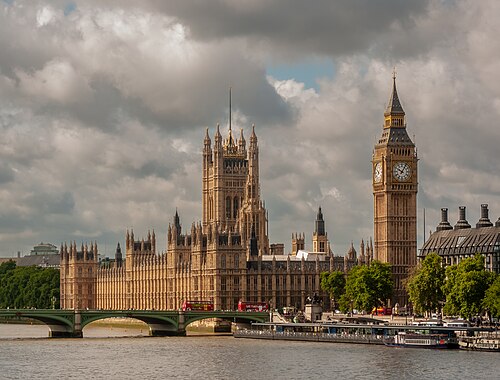
On its own, England has neither a constitution nor a Parliament.[154] Historically though, the evolution of the English Parliament shaped the current UK Parliament, and England is credited with originating what we now know as the Westminster system![]() of representative democracy. Key elements of this government form include: a Cabinet composed of members of the legislature, the presence of an "Official Opposition
of representative democracy. Key elements of this government form include: a Cabinet composed of members of the legislature, the presence of an "Official Opposition![]() ", a legislature that can be dissolved
", a legislature that can be dissolved![]() for snap elections
for snap elections![]() at any time, and a ceremonial head of state that is separate from the head of government.
at any time, and a ceremonial head of state that is separate from the head of government.
The UK Parliament has 532 voting constituencies in England, out of a total of 650. This is the extent of England's role in electing a legislature. Scotland, Wales, and Northern Ireland, meanwhile, have had their own elected legislatures ever since a 1997 set of referendums.[155] How much power these countries should have in relation to the UK Parliament is still a matter of debate.
English common law, is a traditional unwritten legal system in England, which was developed over many centuries and relies on established precedent to shape legal decisions. The English legal system was passed on to many countries established by English colonialism, with modernized versions of English common law used by all US states save Louisiana (which is more influenced by the Napoleonic Code).[156] Countries like Australia, Singapore, and Tanzania have legal systems that adhere even more closely to English common law.[157] Common law, combined with statutes, function in place of an established English constitution. This is why England and the UK are often said to have "unwritten constitutions".
English nationalism[edit]

About a third of English citizens describe themselves as English first and foremost, although these people are most frequently rural and working-class individuals without university education.[158] This is where the ideology of English nationalism thrives, and this has been used as a convenient explanation for England's decision to vote 'yes' on the Brexit referendum.[158] While Brexit shone a light on English nationalism, it had also manifested before in the surprise victory for David Cameron in the 2015 United Kingdom general election due to nervousness at the rise of the Scottish National Party.[158] It is also seen in the Conservative Party's rising appeal to working class voters, which helped deny Jeremy Corbyn a majority in the 2017 United Kingdom general election.
While nationalism in other parts of the UK tends to be left of centre and social democratic in nature, nationalism in England tends to be right-wing. A 2018 London School of Economics Survey showed that English nationalism was associated with support for a hard Brexit, ending free movement, establishing independent trade deals, and establishing "red lines" for retaining English sovereignty.[159] The same survey also found that English nationalists were more likely to believe that ancestry is an important part of being English, and they were more likely to agree with questions proposing racist themes.[159] It can be therefore concluded that English nationalism does have an ethnocentric component to it, with an emphasis on ancestry as a prerequisite for being English, therefore creating a barrier against outsiders.
Self-government in other parts of the UK, along with factors such as immigration, the West Lothian question (in which Scottish and Welsh MPs are allowed to vote on matters affecting England only, with English MPs holding no equivalent right[160]), political correctness taken to extremes, recession, the lack of a national anthem for England, and careful race baiting by British tabloids such as The Sun, the Daily Express, and the Daily Mail, has seen a significant rise in English nationalism in the 21st century.[161]
Religion[edit]

While England's history was shaped by conflict between Christian denominations, England today is no longer a majority Christian country, although it remains a plurality. The 2021 census revealed that only 46.2% of respondents identified as Christians, which was a decrease of 13.1 percentage points from the 2011 census.[4] "No religion" had the second-highest share at 37.2%, which was an increase of 12 from the 2011 census.[4] Of the remainder, 6.5% were Muslim, 1.7% were Hindu, 0.9% were Sikh, and 0.5% were Jewish.[4] In short, England is now a very religiously diverse country, albeit with a commanding majority being either Christians or some flavor of atheist or agnostic. Irreligion also has a commanding majority among English people under 40, leading to speculation that England could become a "no religion"-majority country in the near future.[162]
The Church of England is the state religion of England, meaning that it has meaningful connections to the government. Specifically, the monarch is the "Supreme Governor" of the Church, and many of its bishops are members of the unelected House of Lords.[163] The monarch must always be a member of the Church, and they must pledge to defend and uphold it. Despite all of this, England maintains freedom of religion. Under the 1998 Human Rights Act, "everyone has the right to freedom of thought, conscience, and religion; this right includes freedom to change his religion or belief and freedom, either alone or in community with others and in public or private, to manifest his religion or belief, in worship, teaching, practice and observance."[164]
That's not to say that religion isn't a source of tension in England, though. 2023 was the worst year for recorded antisemitic incidents across the UK since 1984.[165] Additionally, Islamic fundamentalism and Islamist groups have cropped up, having been responsible for the 7 July 2005 London bombings and other terrorist attacks. In 2019, a survey indicated that over a third of people across the UK viewed Islam in general as a threat to the British way of life.[166] In 2024, the UK government issued a stricter definition of extremism, stating it as "the promotion or advancement of an ideology based on violence, hatred or intolerance" in such a manner that would undermine the UK's democracy and seeks to undermine rights and freedoms.[167] Over 400 UK imams rejected the new definition.[168]
The English language[edit]

English is the third-most widely spoken language in the world in terms of native speakers, and when the list expands to include people who speak it as a second or third language, it jumps to the number one spot.[169] Because of this, English has become the standard language of international business, with companies like Airbus, Nokia, Renault, and Samsung mandating it as their common corporate language.[170] What can make this frustrating is that English is a broken, nonsensical excuse for a language.
Don't believe us? Just say these words out loud: through, though, thought, trough, tough, thou. Or better yet, it's a language where this is a real sentence: "James while John had had had had had had had had had had had a better effect on the teacher![]() ". Like, what the fuck? English also has lots of contronyms, which are words that mean totally different things depending on the context.[171] Or you can try on some homonyms, which are words that are spelled exactly the same but have different meanings and sometimes even totally different pronunciations.[172] And have you ever heard this phrase about spelling, "I before E except after C?" It's a straight-up lie.[173]
". Like, what the fuck? English also has lots of contronyms, which are words that mean totally different things depending on the context.[171] Or you can try on some homonyms, which are words that are spelled exactly the same but have different meanings and sometimes even totally different pronunciations.[172] And have you ever heard this phrase about spelling, "I before E except after C?" It's a straight-up lie.[173]
All of this makes English a vibrant language that can be quite beautiful at times, but it also means that trying to learn English as a foreign language can make people feel like they're going insane. It is actually commonly cited as one of the world's hardest languages for non-native speakers to master.[174] So have some empathy for people who don't speak it too well. They're literally trying to learn a language that doesn't even follow its own stated rules.
So why is English like this? Well, a lot of it is because the language formed as a result of a bunch of other languages getting slammed into each other during periods of conquest and migration. Old English was a Germanic tongue that formed due to the Angles, Saxons and Jutes mixing their dialects together.[175] For context, Old English looked like this:[176]
“”Eft he axode, hu ðære ðeode nama wære þe hi of comon. Him wæs geandwyrd, þæt hi Angle genemnode wæron. Þa cwæð he, "Rihtlice hi sind Angle gehatene, for ðan ðe hi engla wlite habbað, and swilcum gedafenað þæt hi on heofonum engla geferan beon."
|
This is utterly incomprehensible to a modern speaker, but it translates into a passage about Pope Gregory I![]() asking someone the Angles.[176] Some Old English words are still around in altered forms, though, like axode (asked), hu (how), rihtlice (rightly), engla (angels), habbað (have), swilcum (such), heofonum (heaven), and beon (be).[176] Old English also lacked they/them pronouns.
asking someone the Angles.[176] Some Old English words are still around in altered forms, though, like axode (asked), hu (how), rihtlice (rightly), engla (angels), habbað (have), swilcum (such), heofonum (heaven), and beon (be).[176] Old English also lacked they/them pronouns.
After William the Conqueror and his Norman pals became influential in 1066, the English language underwent a dramatic change. French became the common language of the nobility, while Latin was the language of literacy and education.[177] Somewhere around this point is where the Great Vowel Shift happened.[178] One example: the "a" in "name" was no longer pronounced the same as the "a" in "father". This is a big part of why English has so many words whose pronunciation bears no resemblance to their spelling. The Renaissance complicated things further, as Greek- and even more Latin-based words entered the Lexicon. Then you had writers like Shakespeare just invent hundreds more words.[179] Colonialism played a role here too, as the English would adopt words that were used across the world, and then the United States had a strong influence on the development of the language.
All attempts to codify the language failed until the first modern dictionary was released in 1775, and English still has no central authority what does and does not become a new word.[177] English, as a result of this disorganization and sheer number of speakers, will likely resist any attempts at simplifying and standardizing it. For a foreign language that's easier to learn, try Spanish or Esperanto.
London[edit]

London, aka "Londonistan" to the alt-right, is was the largest city (by population) in the European Union and is the political and financial capital of the United Kingdom, its affiliated colonies, and England itself. England is often referred to as a "London-centric" country – meaning that without London, England would be a non-entity on the world stage - however, while certainly true for London as a political and financial centre, this simplistic view ignores the enormous technological, scientific, and historical prestige of the rest of the country, much to the annoyance of those who live outside of London. It is no surprise, therefore, that the city is frequently derided by those who live in the UK's other major cities as over-hyped and over-priced[180] - whether this is true for any one person largely falls down to personal experience and the limit on their credit card.
London is also notable for being the world's top financial centre as of 2024, with New York City variably tying with it or slipping into second place during recent years.[181] It is also the only city outside of China to rank in the top 10 for most surveillance cameras on the streets (67.47 per 1,000 people).[182] London Metropolitan Police consider "live facial recognition" technology to be an important supplement to the city's surveillance regime, and dismissed concerns raised by residents and privacy advocates in 2024.[183]
The city has also become extremely diverse. The 2022 census found that 40% of the city's population is foreign-born, compared to 16% across England overall.[184] Of the London population, though, only 25.3% identify with a religion other than "Christian," and only 15% identified as Muslims.[185]
The Mayor of London (not to be confused with the Lord Mayor of the City of London, who presides only over the tiny quasi-independent city-state itself (population: a few thousand) and not over the outlying townships (population: several million) as an elected position is relatively new (2000 CE).[186] Leftist Ken Livingstone was the first to hold this position. "Red Ken" was considered too left for the rebranded Labour Party (which ironically is now a right-wing party). From 2008-16 the mayor was the Tory dipshit and future prime minister Boris Johnson (who couldn't organise a piss-up in a brewery, though he frequently gives the impression of having recently attended one) after beating out Labour rival Livingstone in the May 2008 election. With Johnson in power, it seemed surprising that London did not collapse into chaos, but only to people who saw past his carefully constructed amiable upper-class-twit image. Its current mayor is - shock, horror! - a Muslim, Labour's Sadiq Khan.
The city is also home to the London underground mosquito.
.jpg)
Big Ben and Westminster Palace.
.jpg)
The Bank Junction.
The London Eye.
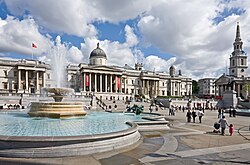
Trafalgar Square.
Counties of England[edit]
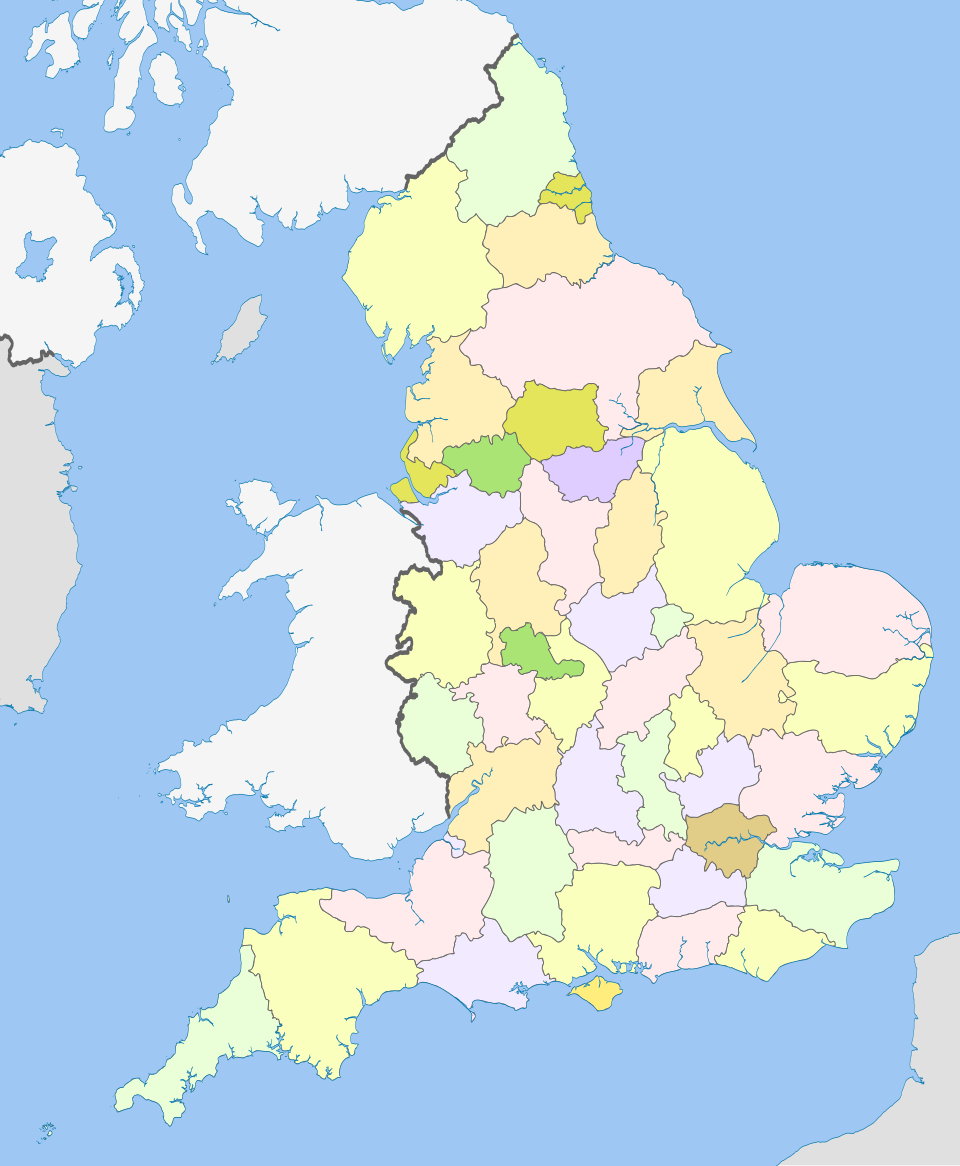
| The 47 English counties | |||||||||||||||||||||||||||||||||||||||||||||||||||||||||||||||||||||||||||||||||||||||||||||||||||
|---|---|---|---|---|---|---|---|---|---|---|---|---|---|---|---|---|---|---|---|---|---|---|---|---|---|---|---|---|---|---|---|---|---|---|---|---|---|---|---|---|---|---|---|---|---|---|---|---|---|---|---|---|---|---|---|---|---|---|---|---|---|---|---|---|---|---|---|---|---|---|---|---|---|---|---|---|---|---|---|---|---|---|---|---|---|---|---|---|---|---|---|---|---|---|---|---|---|---|---|
| County | |||||||||||||||||||||||||||||||||||||||||||||||||||||||||||||||||||||||||||||||||||||||||||||||||||
| 30px Tyne and Wear | |||||||||||||||||||||||||||||||||||||||||||||||||||||||||||||||||||||||||||||||||||||||||||||||||||
Gallery[edit]
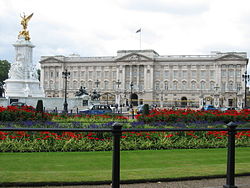
Buckingham Palace, official residence of the King.
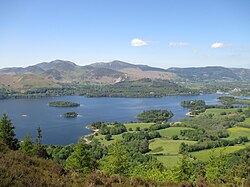
A view in England's Lake District.

Roast lamb with Yorkshire pudding and potatoes.

Students at Nottingham Academy celebrate Pride.
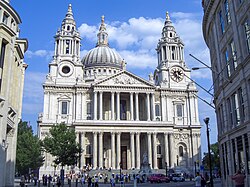
St. Paul's Cathedral in London.
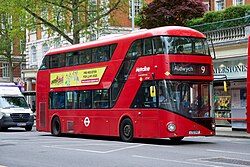
A New Routemaster bus in London.
See also[edit]
| For those of you in the mood, RationalWiki has a fun article about England. |
- English Defense League: A more horrible version of the BNP, or a bunch of football hooligans looking for a punch-up?
- English Democrats: A less horrible version of the BNP, or a legit political party that just wants an English parliament?
- Northern Ireland: on a different island from England, but, like the three countries of Great Britain, part of the United Kingdom.
- Scotland: Borders England to the north.
- United Kingdom: Has its capital in England.
- United States: The home of New England, which is, um, newer than England. (Many towns there are named after English towns. To list them all would be tiresome.)
- New Hampshire: A state in the United States named after an English county.
- Wales: Borders England to the west.
- Fun:Really embarrassing Brits, of all political stripes.
- King Arthur: The mythical greatest king of all of England.
References[edit]
- ↑ On Liberty: Chapter 3: Of Individuality, as One of the Elements of Well-Being by John Stuart Mill (1859) Utilitarianism.net.
- ↑ Dining After 'Downton Abbey': Why British Food Was So Bad For So Long. NPR. Feb. 19, 2012.
- ↑ ‘It damages our free spirit’: war on British tourists won’t work, say Amsterdammers. The Guardian. 31 Mar 2023.
- ↑ 4.0 4.1 4.2 4.3 Religion, England and Wales: Census 2021. UK Office for National Statistics.
- ↑ Population estimates for the UK, England, Wales, Scotland, and Northern Ireland: mid-2022. UK Office for National Statistics.
- ↑ Why does England not have its own parliament? Centre on Constitutional Change.
- ↑ Don't neglect the UK's indigenous languages, Rhona NicDhùghaill, The Guardian 29 October 2013
- ↑ First humans arrived in Britain 250,000 years earlier than thought. The Guardian.
- ↑ "Homo antecessor" - eFossils Resources
- ↑ Choi, Charles (May 3, 2023). "Modern humans migrated into Europe in 3 waves, 'ambitious and provocative' new study suggests". Live Science.
- ↑ Higham T, Compton T, Stringer C, Jacobi R, Shapiro B, Trinkaus E, Chandler B, Gröning F, Collins C, Hillson S, O'Higgins P, FitzGerald C, Fagan M. "The earliest evidence for anatomically modern humans in northwestern Europe." Nature. 2011 Nov 2;479(7374):521-4. doi: 10.1038/nature10484. PMID: 22048314.
- ↑ Pettitt, Paul; White, Mark (2012). The British Palaeolithic: Human Societies at the Edge of the Pleistocene World. Abingdon, UK: Routledge. ISBN 978-0-415-67455-3.
- ↑ "U-series dating suggests Welsh reindeer is Britain’s oldest rock art" - University of Bristol (June 29, 2012)
- ↑ "Early Cultures of the British Isles" - History Files
- ↑ Ashton, Nick (2017). Early Humans. London: William Collins. ISBN 978-0-00-815035-8.
- ↑ Oppenheimer, Stephen (2006). Origins of the British. Carroll & Graf. ISBN 978-0-7867-1890-0. p. 173.
- ↑ First Britons. Natural History Museum.
- ↑ Brace S, Diekmann Y, Booth TJ, van Dorp L, Faltyskova Z, Rohland N, Mallick S, Olalde I, Ferry M, Michel M, Oppenheimer J, Broomandkhoshbacht N, Stewardson K, Martiniano R, Walsh S, Kayser M, Charlton S, Hellenthal G, Armit I, Schulting R, Craig OE, Sheridan A, Parker Pearson M, Stringer C, Reich D, Thomas MG, Barnes I. "Ancient genomes indicate population replacement in Early Neolithic Britain." Nat Ecol Evol. 2019 May;3(5):765-771. doi: 10.1038/s41559-019-0871-9. Epub 2019 Apr 15. Erratum in: Nat Ecol Evol. 2019 Jun;3(6):986-987. doi: 10.1038/s41559-019-0912-4. PMID: 30988490; PMCID: PMC6520225.
- ↑ Arrival of Beaker folk changed Britain for ever, ancient DNA study shows. The Guardian.
- ↑ Bronze Age Beaker People of Stonehenge. Odyssey Traveller.
- ↑ Early migration from France may have brought Celtic languages to Britain. Science. 22 Dec 2021.
- ↑ 22.0 22.1 22.2 The Celts in Britain: everything you need to know. History Extra.
- ↑ History of Hadrian’s Wall. English Heritage.
- ↑ 24.0 24.1 24.2 24.3 Everything you wanted to know about Roman Britain – but were afraid to ask. History Extra.
- ↑ The death of the druids. BBC.
- ↑ 26.0 26.1 Boudicca. World History Encyclopedia.
- ↑ Boudica: Warrior queen of the Iceni. Live Science.
- ↑ British History: Roman Britain. BBC.
- ↑ 29.0 29.1 29.2 Migration, not conquest, drove Anglo-Saxon takeover of England. Science.
- ↑ 30.0 30.1 30.2 30.3 Anglo-Saxons: a brief history. Historical Association.
- ↑ Was King Arthur a Real Person? Smithsonian Magazine.
- ↑ Is English a Germanic Language? A Deep Dive. Rosetta Stone.
- ↑ 33.0 33.1 33.2 33.3 33.4 33.5 The 7 Great Kingdoms of the Anglo-Saxons. History Hit.
- ↑ Offa's Dyke. BBC.
- ↑ Queen Seaxburh of Wessex. Swords and Sceptres.
- ↑ Heptarchy. English History.
- ↑ 37.0 37.1 37.2 37.3 Migration and conversion: The Christianisation of Britain. Our Migration Story.
- ↑ 38.0 38.1 Who was St Augustine? English Heritage.
- ↑ 39.0 39.1 The Viking Raid on Lindisfarne. English Heritage.
- ↑ The Vikings in Britain: a brief history. Historical Association.
- ↑ 41.0 41.1 41.2 41.3 The Great Heathen Army. Historic UK.
- ↑ The City of Dublin. Vikingeskibs Museet.
- ↑ 43.0 43.1 43.2 The History of the Vikings in England. English Heritage.
- ↑ 44.0 44.1 The Danelaw: is the ‘realm’ of the Vikings in Anglo-Saxon-era England a place or an idea? History Extra.
- ↑ 45.0 45.1 45.2 Viking Words: The Old Norse Influence on English. Life in Norway.
- ↑ 46.0 46.1 46.2 Alfred the Great. Historic UK.
- ↑ 47.0 47.1 Who was Edward the Elder? A brief guide to the Anglo-Saxon king History Extra.
- ↑ 48.0 48.1 48.2 Æthelstan and the foundation of England: your guide to the 'first king of the English'. History Extra.
- ↑ 49.0 49.1 49.2 49.3 When England was Part of a Viking Empire. Sons of Vikings.
- ↑ The story behind how Bluetooth® technology got its name. Bluetooth.
- ↑ 51.0 51.1 51.2 Edward The Confessor. Historic UK.
- ↑ 52.0 52.1 52.2 The Norman Conquest. Historic UK.
- ↑ Duchy of Normandy. History Files.
- ↑ Who Was William the Conqueror? Bayeux Museum.
- ↑ Harald Hardrada - King of Norway 1046-1066. Vikingeskibsmuseet.
- ↑ The Battle of Stamford Bridge. Historic UK.
- ↑ The Battle of Hastings. Historic UK.
- ↑ Medieval Dynasties: The House of Normandy. Medieval Britain.
- ↑ 59.0 59.1 The Conquest and its Aftermath. BBC.
- ↑ Tower of London. UNESCO World Heritage Convention.
- ↑ Revolt, resistance and control in Norman England: The Harrying of the North. BBC.
- ↑ 62.0 62.1 Was William the Conqueror a war criminal? The brutal story of the Harrying of the North. History Extra.
- ↑ The Domesday Book. Historic UK.
- ↑ The establishment of Norman rule over England. BBC.
- ↑ 65.0 65.1 The Norman Feudal System. Spartacus Educational.
- ↑ 66.0 66.1 66.2 1066 and all those baby names. BBC News.
- ↑ Who Were William the Conqueror’s Sons? History Hit.
- ↑ 68.0 68.1 68.2 The 4 Norman Kings Who Ruled England in Order. History Hit.
- ↑ 69.0 69.1 Anselm. Spartacus Educational.
- ↑ 70.0 70.1 70.2 70.3 What Was the White Ship Disaster? History Hit.
- ↑ 71.0 71.1 71.2 How Did The White Ship Disaster End a Dynasty? History Hit.
- ↑ The Medieval Power Struggle That Inspired HBO’s ‘House of the Dragon’. Smithsonian Magazine.
- ↑ King Stephen and The Anarchy. Historic UK.
- ↑ 74.0 74.1 Empress Maud. Historic UK.
- ↑ 75.0 75.1 75.2 Your guide to the Anarchy, the bloody battle between Stephen and Matilda. History Extra.
- ↑ Eleanor of Aquitaine. English Heritage.
- ↑ The Angevin Empire. English Heritage.
- ↑ 78.0 78.1 78.2 King Henry II. Historic UK.
- ↑ 79.0 79.1 79.2 Thomas Becket. Historic UK.
- ↑ 80.0 80.1 Thomas Becket: the murder that shook the Middle Ages. The British Museum.
- ↑ Marking the Norman invasion of Ireland: 850 years and counting . . . Irish Times.
- ↑ 82.0 82.1 82.2 82.3 Richard I of England. World History Encyclopedia.
- ↑ The Massacre at Clifford’s Tower. English Heritage.
- ↑ 84.0 84.1 84.2 84.3 [https://www.worldhistory.org/King_John_of_England/ King John of England]. World History Encyclopedia.
- ↑ Your guide to King John, the monarch who issued Magna Carta. History Extra.
- ↑ 86.0 86.1 King Henry III. Historic UK.
- ↑ The Reforms of 1258 . UK Parliament.
- ↑ 88.0 88.1 88.2 88.3 Edward Longshanks & the Conquest of Wales. The Collector.
- ↑ 89.0 89.1 89.2 89.3 89.4 Edward I 'Longshanks' (r. 1272-1307). Royal.uk
- ↑ 90.0 90.1 90.2 The True Story of Robert the Bruce, Scotland’s ‘Outlaw King’. Smithsonian Magazine.
- ↑ William Wallace (c. 1270 - 1305). BBC.
- ↑ 92.0 92.1 92.2 92.3 92.4 92.5 [https://www.worldhistory.org/Edward_III_of_England/ Edward III of England]. World History Encyclopedia.
- ↑ Peasants' Revolt. World History Encyclopedia.
- ↑ [https://www.worldhistory.org/Richard_II_of_England/ Richard II of England]. World History Encyclopedia.
- ↑ Henry IV of England. World History Encyclopedia.
- ↑ Lollards. BBC.
- ↑ John Wycliffe. World History Encyclopedia.
- ↑ 98.0 98.1 Henry V of England. World History Encyclopedia.
- ↑ 99.0 99.1 Hundred Years' War. World History Encyclopedia.
- ↑ 100.0 100.1 100.2 100.3 Henry VI of England. World History Encyclopedia.
- ↑ 101.0 101.1 101.2 Wars of the Roses: An Overview. ThoughtCo.
- ↑ 102.0 102.1 102.2 102.3 102.4 Wars of the Roses. World History Encyclopedia.
- ↑ The Battle of Towton. Historic UK.
- ↑ 104.0 104.1 104.2 Edward IV of England. World History Encyclopedia.
- ↑ 105.0 105.1 The Wars of the Roses: Who Fought and Why? History Today.
- ↑ 106.0 106.1 Henry VII and Local Government. History Learning Site.
- ↑ Henry VII (r. 1485-1509). Royal.uk
- ↑ 108.0 108.1 108.2 108.3 Henry VII of England. World History Encyclopedia.
- ↑ Catherine of Aragon. World History Encyclopedia.
- ↑ Henry VIII’s French Wars (1512-1546). Dave Does History.
- ↑ 111.0 111.1 111.2 Henry VIII of England. World History Encyclopedia.
- ↑ Why did Henry VIII break with Rome? Royal Museums Greenwich.
- ↑ 113.0 113.1 English Reformation. World History Encyclopedia.
- ↑ Anne Boleyn: your guide to the life and death of Henry VIII's second queen – plus 11 little-known facts. History Extra.
- ↑ Thomas More (1478 - 1535). BBC.
- ↑ 116.0 116.1 Dissolution of the Monasteries. World History Encyclopedia.
- ↑ 117.0 117.1 117.2 Who were Henry VIII's wives? Royal Museums Greenwich.
- ↑ 118.0 118.1 118.2 118.3 118.4 Edward VI of England. World History Encyclopedia.
- ↑ 119.0 119.1 119.2 Mary I of England. World History Encyclopedia.
- ↑ 120.0 120.1 120.2 Why is Mary I known as 'Bloody Mary'? Royal Museums Greenwich.
- ↑ Elizabeth I's religious settlement. Royal Museums Greenwich.
- ↑ 122.0 122.1 122.2 122.3 The Elizabethan Religious Settlement. World History Encyclopedia.
- ↑ 123.0 123.1 123.2 123.3 Elizabeth I of England. World History Encyclopedia.
- ↑ Elizabeth I (1533–1603). Encyclopedia Virginia.
- ↑ Spanish Armada. World History Encyclopedia.
- ↑ Queen Elizabeth I: Colonising America. Royal Museums Greenwich.
- ↑ 127.0 127.1 127.2 James I of England. World History Encyclopedia.
- ↑ Why was King James VI and I obsessed with witch hunts? History Extra.
- ↑ The First Residents of Jamestown. National Park Service.
- ↑ Blog Post The Mayflower Compact. Mass.gov
- ↑ 131.0 131.1 Tobacco: The Early History of a New World Crop. National Park Service.
- ↑ A brief history of James VI and I. National Museums Scotland.
- ↑ Charles I of England. World History Encyclopedia.
- ↑ Petition of Right. World History Encyclopedia.
- ↑ 135.0 135.1 The Origins & Causes of the English Civil War. Historic UK.
- ↑ 136.0 136.1 English Civil Wars. World History Encyclopedia.
- ↑ King Charles I. Historic UK.
- ↑ The English Protectorate. Lumen Learning.
- ↑ Life in England under Oliver Cromwell. History Learning Site.
- ↑ Oliver Cromwell. Historic UK.
- ↑ Haley, K.H.D. (1985). Politics in the Reign of Charles II. Oxford: Basil Blackwell. ISBN 0-631-13928-1. p. 5.
- ↑ 142.0 142.1 142.2 Charles II of England. World History Encyclopedia.
- ↑ Indentured Servants in Colonial Virginia. Encyclopedia Virginia.
- ↑ Bacon’s Rebellion (1676–1677). Encyclopedia Virginia.
- ↑ Slavery in Colonial America. American Battlefield Trust.
- ↑ James II of England. World History Encyclopedia.
- ↑ 147.0 147.1 The Glorious Revolution 1688. Historic UK.
- ↑ On this day, the English Bill of Rights makes a powerful statement. National Constitution Center.
- ↑ 149.0 149.1 149.2 149.3 149.4 William III of England. World History Encyclopedia.
- ↑ The Act of Settlement. UK Parliament.
- ↑ 151.0 151.1 Anne, Queen of Great Britain. World History Encyclopedia.
- ↑ The Darien Scheme. Historic UK.
- ↑ 153.0 153.1 153.2 The Union of 1707: the Historical Context. Scottish History Society.
- ↑ England: Government and society. Britannica.
- ↑ What is devolution and how does it work in the UK? BBC News.
- ↑ common law. Law.com Legal Dictionary.
- ↑ Common Law Countries 2024. World Population Review.
- ↑ 158.0 158.1 158.2 Nationalism in England is not just a rightwing nostalgia trip. The Guardian.
- ↑ 159.0 159.1 Nationalism, racism, and identity: what connects Englishness to a preference for hard Brexit? London School of Economics.
- ↑ English nationalism 'threat to UK' - www.bbc.co.uk
- ↑ "Britain wants UK break up, poll shows" - Daily Telegraph, November 2006
- ↑ Census data suggests UK faces ‘non-religious future’, say campaigners. The Guardian. 30 Jan 2023.
- ↑ The relationship between church and state in the United Kingdom. UK Parliament.
- ↑ 2022 Report on International Religious Freedom: United Kingdom. US State Department.
- ↑ UK records worst year for antisemitism after outbreak of Israel-Hamas war. Reuters.
- ↑ Third of Britons believe Islam threatens British way of life, says report. The Guardian.
- ↑ UK redefines extremism after rise in hate crimes against Jews, Muslims. Reuters.
- ↑ Over 400 UK imams reject new extremism definition targeting Muslim groups. Middle East Eye.
- ↑ The 10 Most Spoken Languages In The World. Babbel.
- ↑ Global Business Speaks English. Harvard Business Review.
- ↑ 75 Contronyms (Words with Contradictory Meanings). Daily Writing Tips.
- ↑ 30 Homographs Examples for Writers. Writer's Digest.
- ↑ I Before E Except After C. The famous rhyme is wrong. Here's why. Merriam-Webster.
- ↑ What Makes English Such A Difficult Language To Learn? United Language Group.
- ↑ 'Green-eyed monster' and 'stiff upper lip’: the evolution of the English language. History Extra.
- ↑ 176.0 176.1 176.2 What are the origins of the English Language? Merriam-Webster.
- ↑ 177.0 177.1 From Old to New: How the English Language Evolved Throughout History. University of Texas.
- ↑ The Great Vowel Shift. Harvard University.
- ↑ Words Shakespeare Invented. No Sweat Shakespeare.
- ↑ It makes no sense to think of London as another country. The capital is us. The Guardian.
- ↑ City of London remains top global financial centre in own survey. Reuters.
- ↑ The Most Surveilled Cities in the World. US News and World Report.
- ↑ Croydon: Met Police to continue facial recognition despite concerns. BBC News.
- ↑ Migrants in the UK: An Overview. University of Oxford Migration Observatory.
- ↑ Religion, England and Wales: Census 2021. Office for National Statistics.
- ↑ Still confused, here's a video.
Categories: [European countries] [Imperialism] [United Kingdom]
↧ Download as ZWI file | Last modified: 11/05/2025 14:01:31 | 359 views
☰ Source: https://rationalwiki.org/wiki/England | License: CC BY-SA 3.0
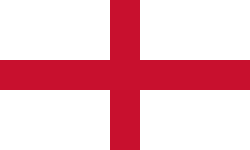

 KSF
KSF